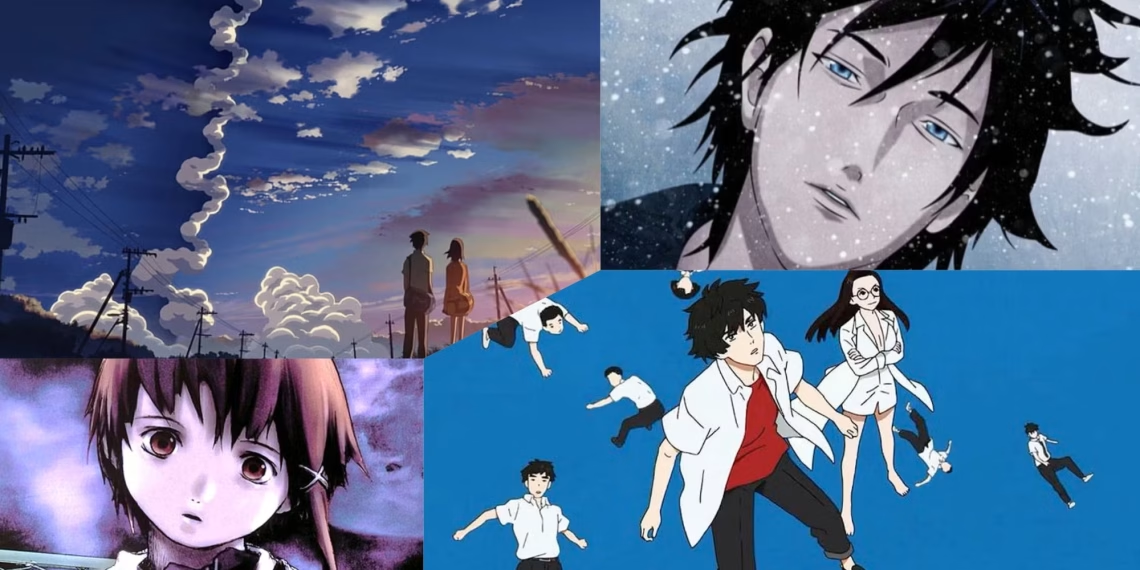Anime frequently investigates the emotional layers of solitude, moving far beyond simple depictions of being alone. It often highlights internal battles—feelings of disconnection, of existing apart from others even in crowded places. This emotional distance is painted in vibrant detail, offering space for empathy and reflection through rich character portrayals and gentle storytelling.
Characters across genres often carry this weight—wandering spirit-hunters, awkward teenagers, or quiet wanderers all reflect various shades of loneliness. Whether it’s a supernatural backdrop or an ordinary school day, the sense of longing resonates, building bridges between the viewer and the animated world onscreen.
Some anime soften the sharpness of loneliness with an atmosphere of warmth and care. These wholesome narratives don’t ignore isolation—instead, they bring it into the open and gently guide characters toward healing through friendship, shared experiences, and small but meaningful moments.
Shows like Barakamon, My Roommate Is a Cat, or A Place Further Than the Universe don’t rush resolution. They allow their characters to stumble and grow, often through quiet acts of kindness or unexpected companionship. In watching these journeys, audiences are reminded of their own capacity for empathy and connection.
Sonny Boy And 9 Other Anime Series Based on Loneliness
Here is a list of the top 10 best anime series that depict loneliness.
10. Aoi Bungaku Series
The Aoi Bungaku Series stands as a testament to the enduring power of classical Japanese literature, offering a contemporary and innovative take on six timeless tales.
Across its 12 episodes, this anime weaves together heartfelt narratives of tragedy, depression, and solitude, delving into the depths of the human psyche and posing poignant existential questions that resonate with audiences across generations.
Each episode of The Aoi Bungaku Series serves as a poignant exploration of the human condition, as protagonists grapple with the tumultuous trials of life. From moments of profound despair to fleeting peeks of hope, the series captures the essence of human emotion with unparalleled depth and nuance.
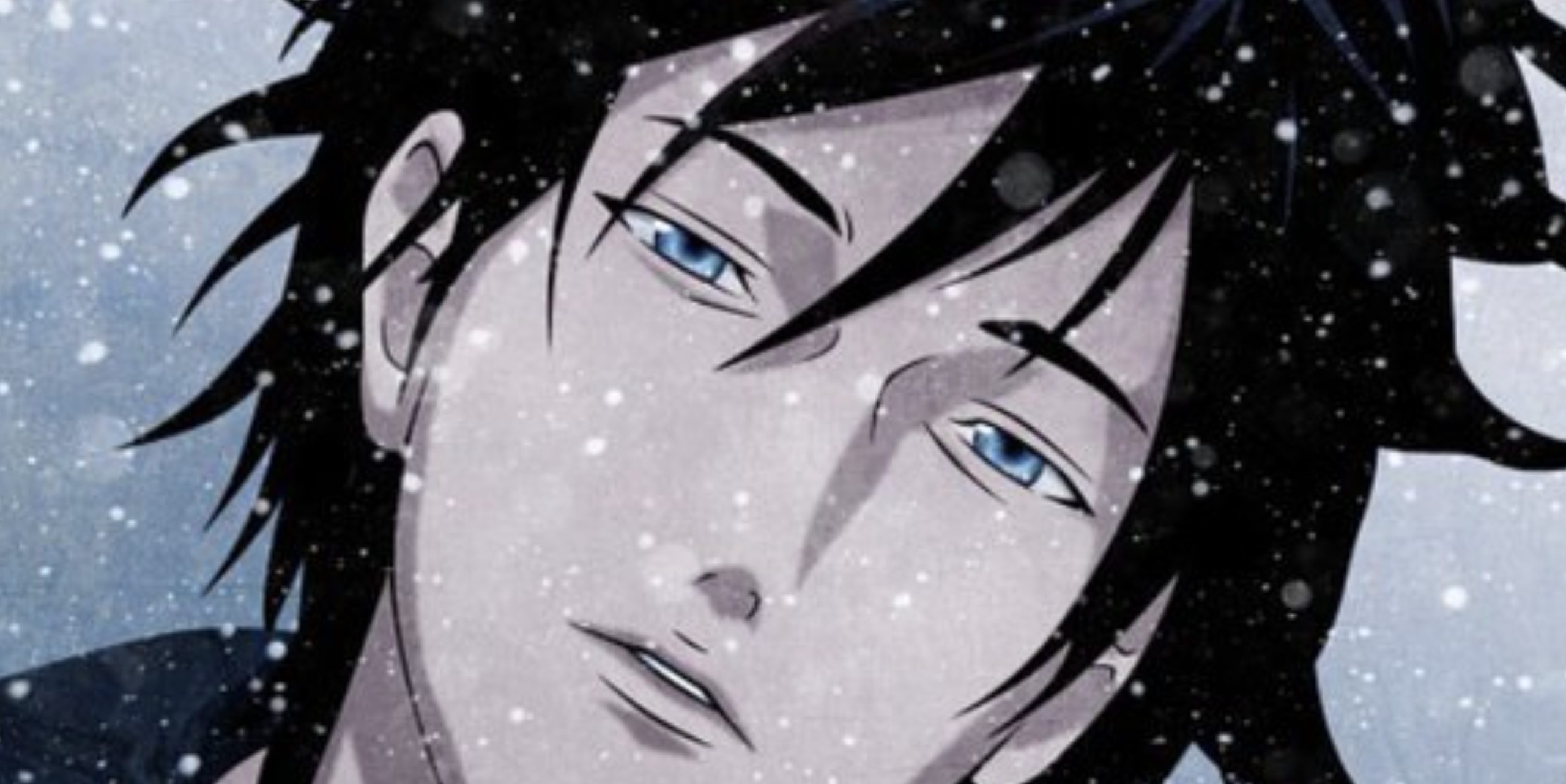
Among the stories brought to life in this anthology is “No Longer Human” by Osamu Dazai, a haunting portrayal of a young man named Oba Yozo who finds himself alienated from society.
Plagued by a sense of existential emptiness and a belief that he is fundamentally different from those around him, Oba’s journey is marked by despair, depression, and thoughts of suicide.
Drawing from the author’s own experiences, “No Longer Human” and the other tales featured in the series offer a stark and unflinching examination of the human psyche, inviting viewers to confront their own innermost fears and insecurities.
Through the medium of anime, The Aoi Bungaku Series breathes new life into these classic works of literature, infusing them with a modern sensibility and visual flair. Each episode serves as a testament to the enduring relevance of these stories, as they continue to resonate with audiences long after their initial publication.
9. Mushi-Shi
Set in a subtly altered rendition of Japan between the Edo and Meiji periods, Mushishi transports viewers into a world where the fabric of reality is interwoven with the presence of “mushi”—primal entities that defy conventional understanding.
Neither inherently good nor evil, these ethereal beings exist beyond the perception of most, yet wield profound influence over the natural world and those who inhabit it.
At the heart of Mushishi lies the introspective journey of Ginko, a tranquil and contemplative individual blessed with the rare ability to perceive and interact with mushi.
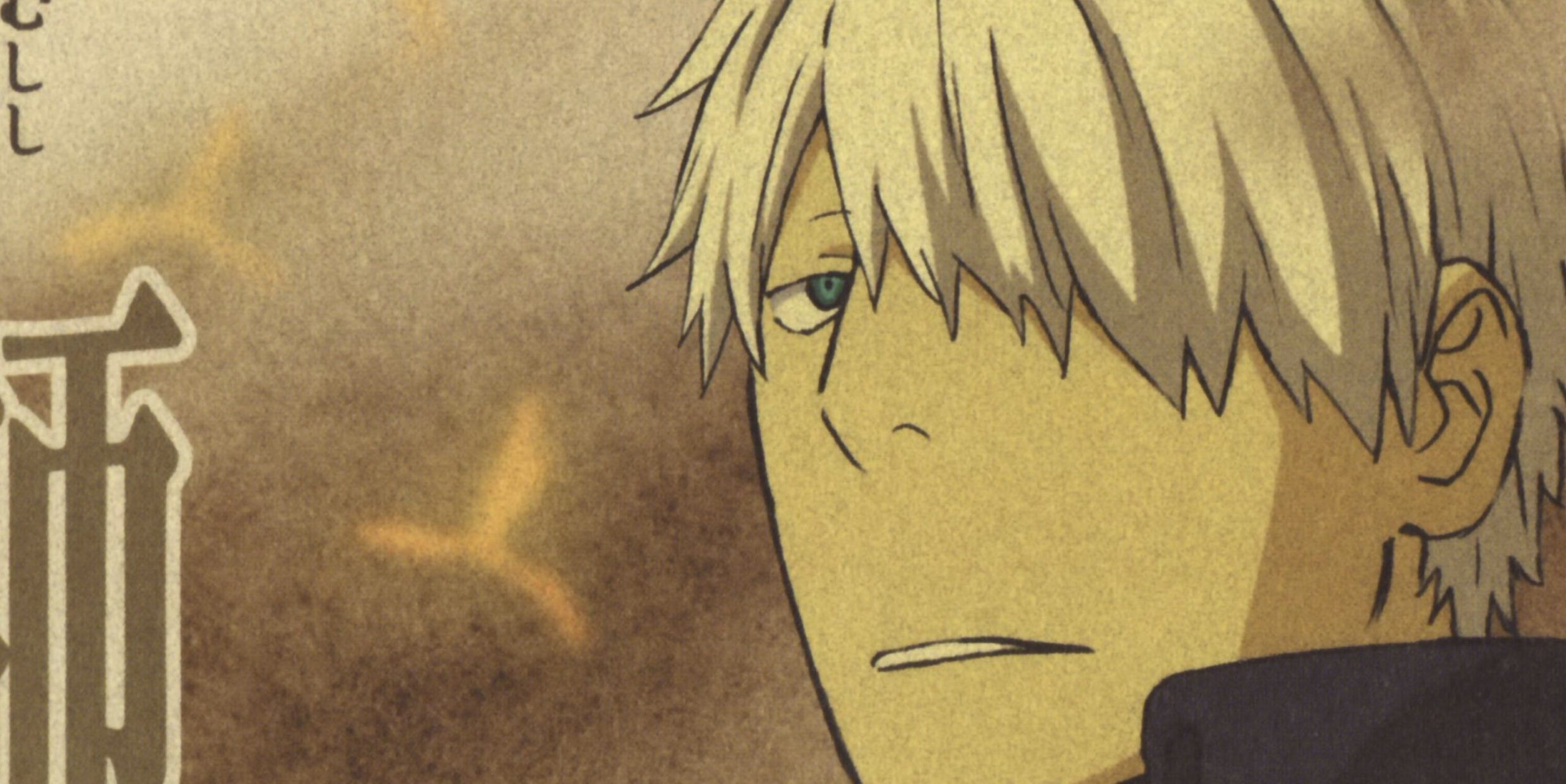
Roaming the serene countryside of Japan in solitary contemplation, Ginko devotes himself to unraveling the mysteries of these elusive beings. Unlike traditional exorcists, his approach is one of curiosity and empathy, seeking not to banish mushi but to comprehend their essence and mitigate the impact of their presence on human lives.
Mushishi is revealed as a serene and slow-paced exploration of the delicate balance between humanity and the unseen forces that shape their existence. Through Ginko’s encounters with those affected by mushi, viewers are treated to mesmerizing vignettes that showcase the profound interplay between the ethereal and the tangible.
Each episode serves as a poignant meditation on the interconnectedness of all life forms, as Ginko explores the complexities of human emotion and the boundless wonders of the natural world.
With its breathtaking animation and evocative storytelling, Mushishi offers an amazing peek into a world where the boundaries between reality and the unknown blur.
Through its tranquil pace and meditative tone, the anime invites viewers to ponder the mysteries of existence and the undercurrents of wonder that permeate the world around us.
8. Welcome To The N.H.K.
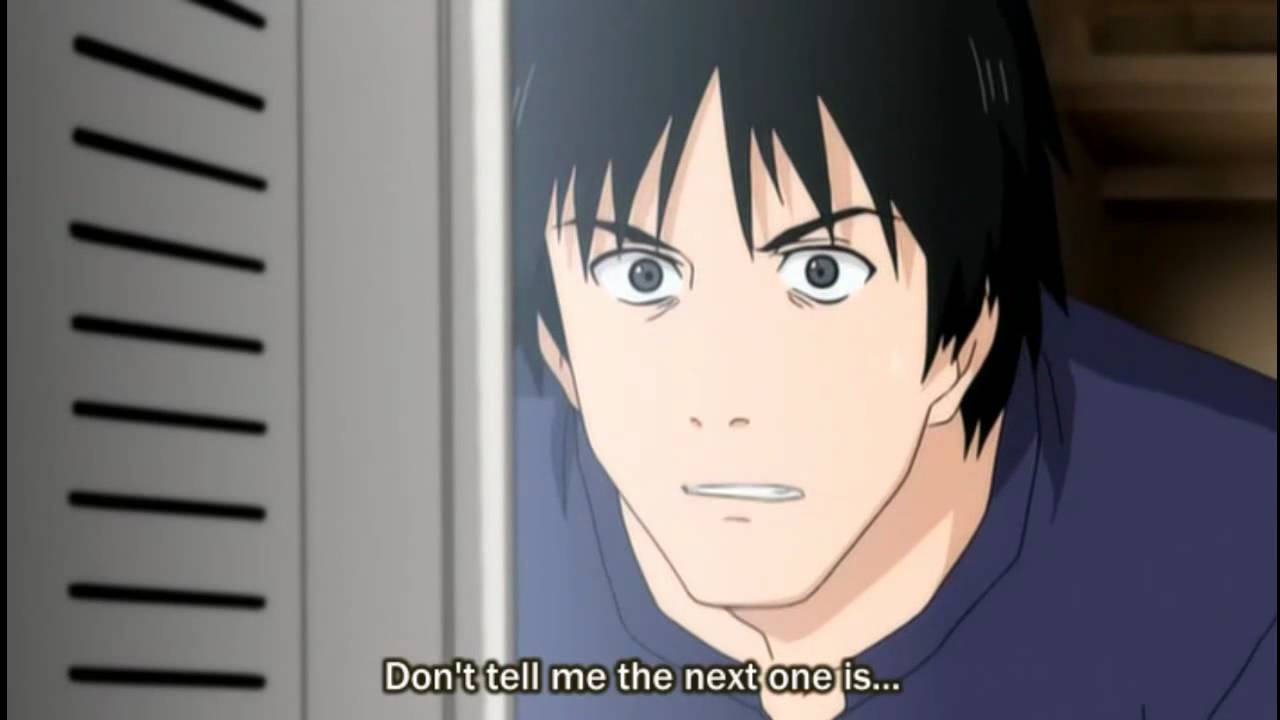
Drawing inspiration from Tatsuhiko Takimoto’s novel, Welcome to the N.H.K. invites viewers into the tumultuous Tatsuhiro Sato, a 22-year-old college dropout ensnared by the grip of hikikomori—a Japanese term covering the plight of social recluses.
Sequestered within the confines of his apartment for years, Tatsuhiro grapples with social anxieties and paranoid delusions, his mind ensnared by visions of a shadowy organization known as the N.H.K. (Nihon Hikikomori Kyokai), which he believes to be the orchestrator of his seclusion and the Hikikomori phenomenon plaguing Japan.
Amidst the haze of his delusions, Tatsuhiro’s solitary existence is disrupted by the unexpected arrival of a woman who takes a keen interest in his well-being.
With the assistance of one of Tatsuhiro’s high school acquaintances, she endeavors to pull him from the suffocating grip of his hikikomori lifestyle, igniting a journey fraught with challenges and self-discovery.

Welcome to the N.H.K. offers a compelling portrayal of mental health struggles, deftly interweaving elements of depression, social anxiety, and existential despair with a touch of dark humor.
Through its nuanced storytelling, the series sheds light on the complexities of the human psyche, delving into the depths of isolation and the quest for connection amidst the darkness.
As Tatsuhiro grapples with his inner demons and confronts the harsh realities of his existence, viewers are offered a peek into the transformative power of human connection and resilience.
Through laughter and tears, the characters explore the tumultuous terrain of mental illness, offering solace and hope to those who find themselves ensnared by similar struggles.
Satou is introduced not as a hero, but as a shut-in who hasn’t left his apartment in years. He blames a shadowy organization—the N.H.K.—for orchestrating his downfall. While absurd on the surface, this delusion mirrors his fear of responsibility. The show uses this idea to study how we create fantasies to shield ourselves from failure and expectations.
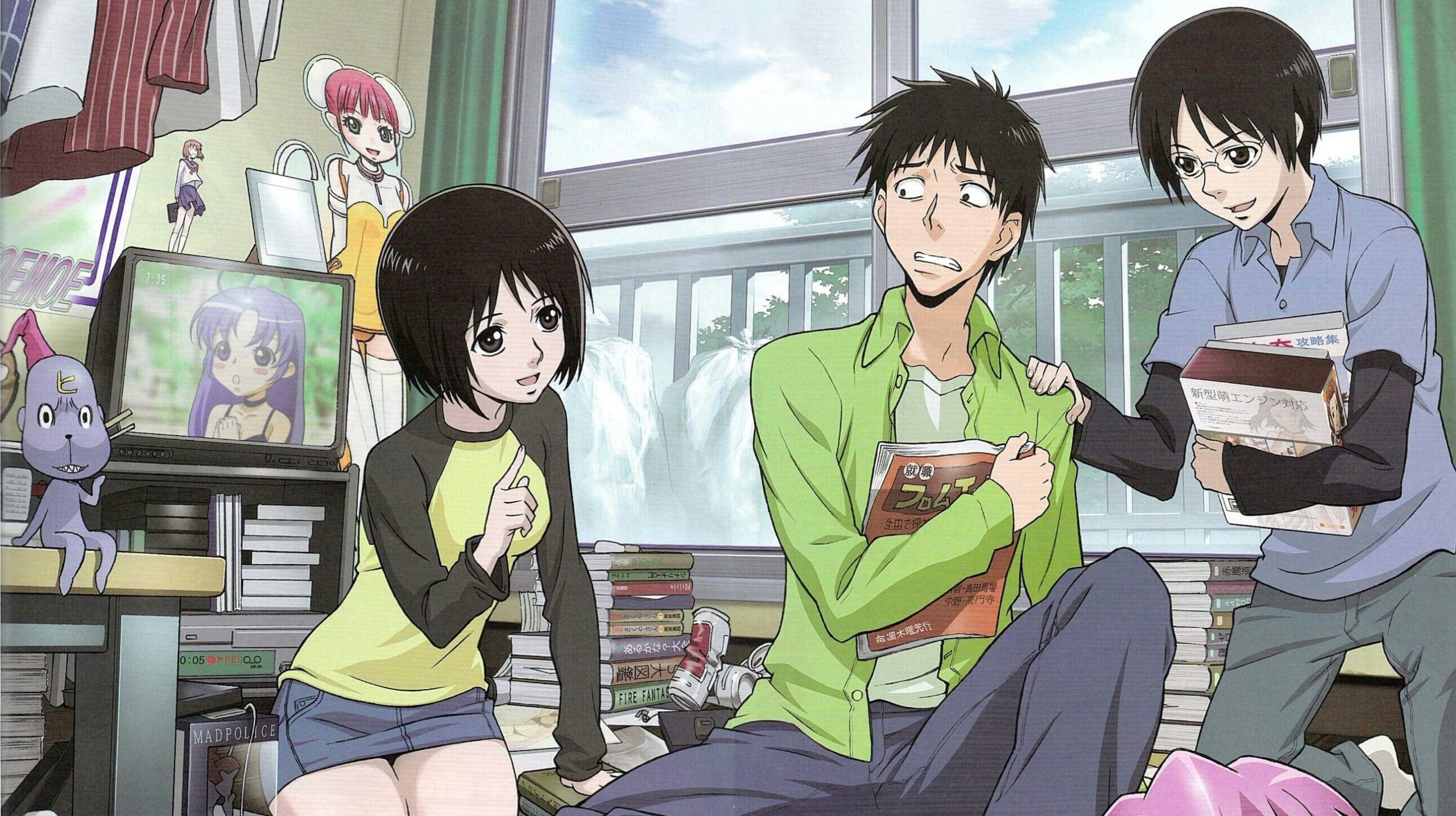
In this darkly comic world, Satou’s interactions are few but significant. When Misaki Nakahara enters his life with a bizarre proposal—to “cure” him—her intentions seem unclear. She’s cheerful, almost to a fault, and always shows up when Satou hits rock bottom. Despite her kindness, there’s an unsettling undertone to her behavior that deepens as the story unfolds.
Satou’s friend Yamazaki provides a sharp contrast. A passionate otaku and game developer, Yamazaki seems more socially functional. But beneath his enthusiasm is a deep insecurity about adulthood. Their conversations are filled with irony and awkwardness, often masking the painful recognition that neither is truly okay. Their shared delusions become a strange form of emotional shelter.
The anime resists easy resolution. Each episode reveals more about the characters’ fractured lives. Satou’s dependency on Misaki is far from romantic—it’s anxious, reactive, and filled with emotional landmines. Misaki herself is battling her own isolation, using her “project” with Satou as a distraction. This mutual brokenness forms the core of their unpredictable relationship.
The show doesn’t romanticize mental illness. Instead, it frames depression, anxiety, and social withdrawal as real and difficult. These aren’t merely plot devices but forces that shape the characters’ lives. By using humor and surreal moments, it makes the heaviness more digestible. But even the jokes carry an undercurrent of sadness and longing.
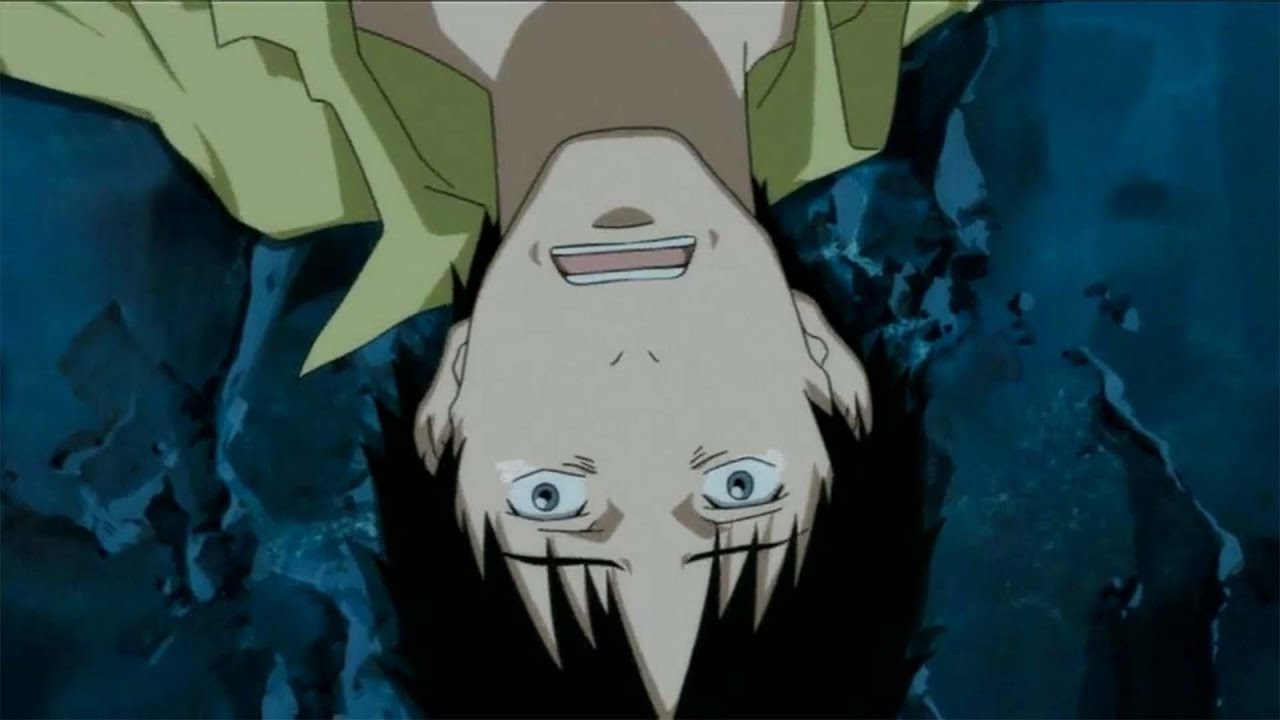
N.H.K. portrays modern alienation with uncomfortable accuracy. It reveals the strange comforts of routines that don’t serve us, and the paradox of feeling alone in a crowded world. The silence of Satou’s room becomes louder than any dialogue. Small gestures—like standing in sunlight or receiving a phone call—carry immense emotional weight.
Misaki’s motivations become more complex as her background is revealed. Her connection to Satou stems not just from kindness, but a deep loneliness and need for control. She masks her pain behind forced optimism, which unravels slowly. The power dynamics in their relationship shift often, exposing both vulnerability and manipulation.
Throughout the series, reality blurs with hallucination. Satou sees appliances talking and imagines conspiracies. But these fantasies are coping mechanisms. Instead of running from them, the show allows viewers to sit with his discomfort. It’s never preachy. It shows the spiral, the relapse, the fear of going outside—and the occasional, fragile victory.
Music and animation subtly amplify this sense of unease. The pastel palette contrasts with themes of despair. Bright scenes carry a dullness that matches the characters’ emotional fatigue. The soundtrack often veers into strange territory, layering tension beneath soft piano chords. The world feels slightly off, mirroring Satou’s mental state.
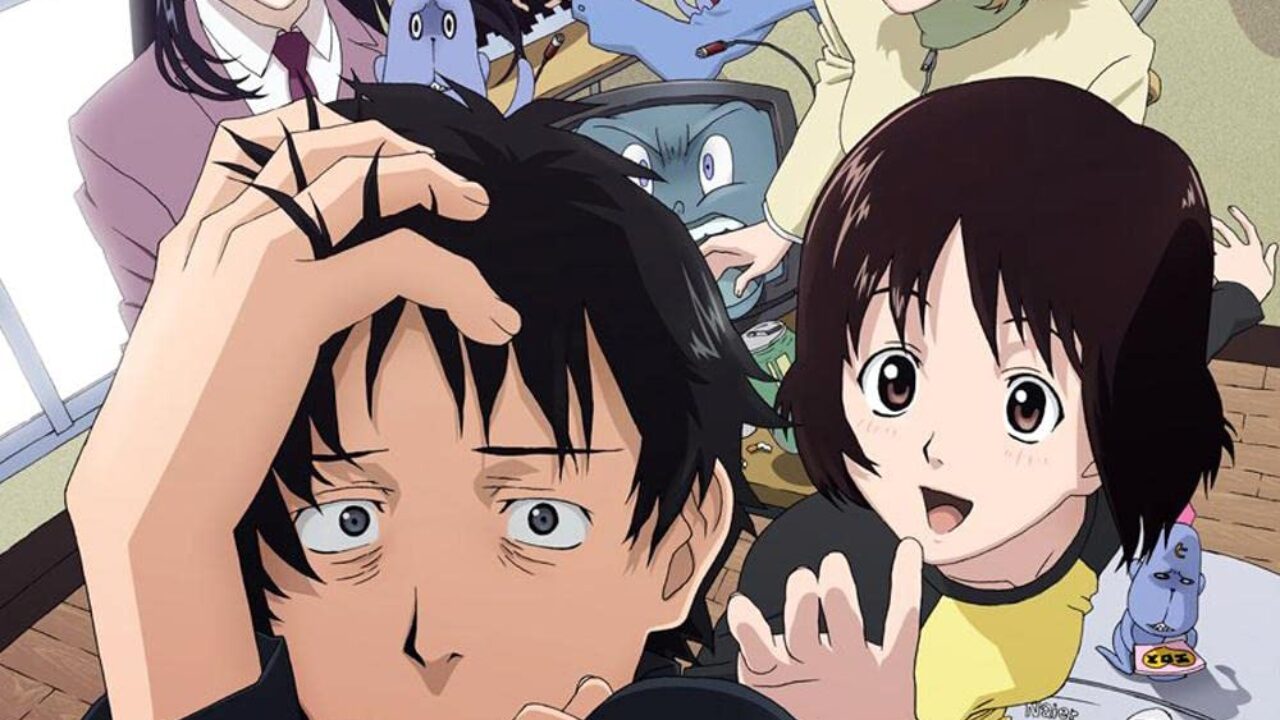
The show’s structure also mirrors its message. There’s no neat arc. Progress is slow and messy. Satou has moments of clarity followed by setbacks. Characters make choices that don’t resolve anything. It reflects life more than fiction—how we don’t always grow in straight lines, and how healing can be uncertain and incomplete.
Yamazaki’s storyline reveals the disillusionment that comes with adulthood. His dreams of creating eroge games fade as he’s pulled into family obligations. He becomes a mirror for Satou’s fears: that even if you leave the room, the outside world may still disappoint you. It challenges the idea that stepping out guarantees success.
The show addresses internet addiction, conspiracy theories, pyramid schemes, and online suicide forums—all through Satou’s desperate attempts to feel less alone. These subplots sound extreme, but they’re rooted in real social issues. The internet becomes both refuge and trap, highlighting how easily isolation is reinforced in digital spaces.
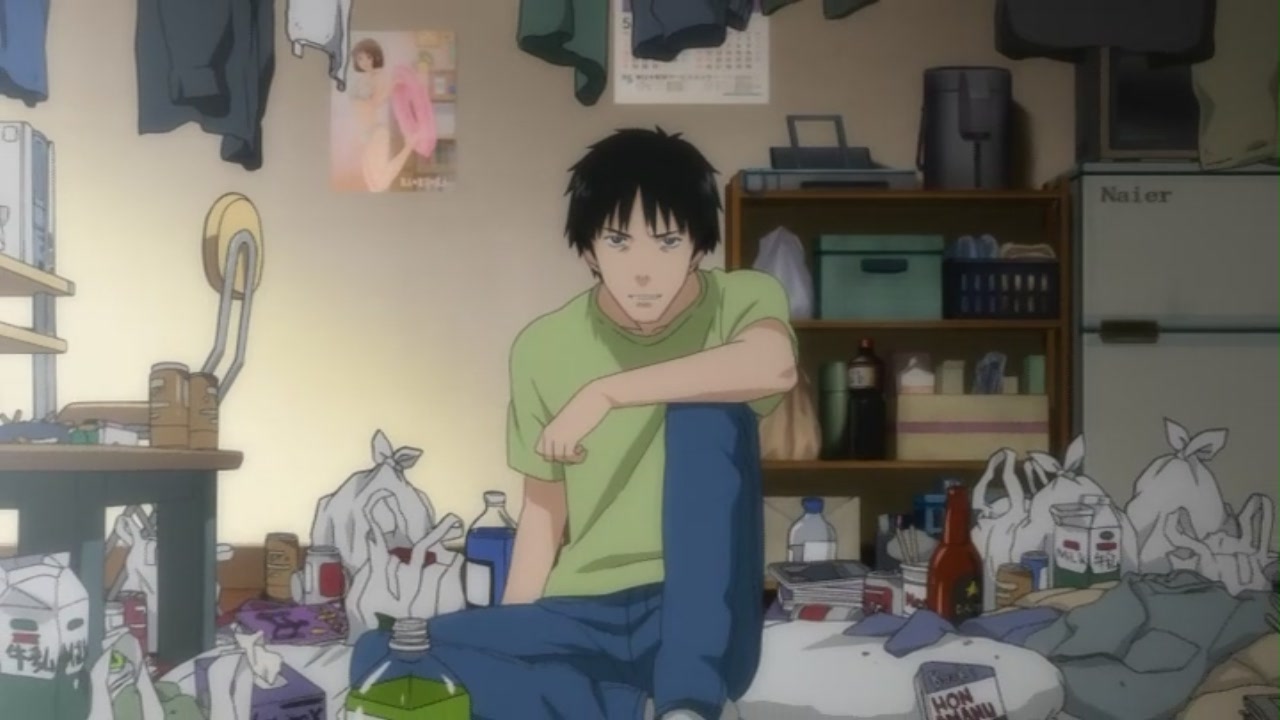
Even moments of joy come with strings attached. Satou’s brief job, Misaki’s small smiles, and Yamazaki’s enthusiasm feel temporary. The story teaches that happiness, like sadness, comes in waves. There’s no climax where everything is fixed. Instead, there are small steps—leaving the apartment, taking a walk, being honest for once.
The final episodes reveal the fragility of recovery. Satou contemplates ending his life, believing he’s beyond help. Misaki’s intervention is imperfect, and her role as a savior crumbles. But that moment breaks something open. Their relationship begins to shift toward honesty rather than dependence. It’s a quiet change, but a significant one.
Misaki’s letter—perhaps the emotional peak of the show—exposes her own traumas. She’s not a fixer; she’s a girl who also needed to be saved. The illusion of a one-sided rescue shatters. Their bond becomes less about healing each other and more about understanding that pain is not exclusive or fixable by force.
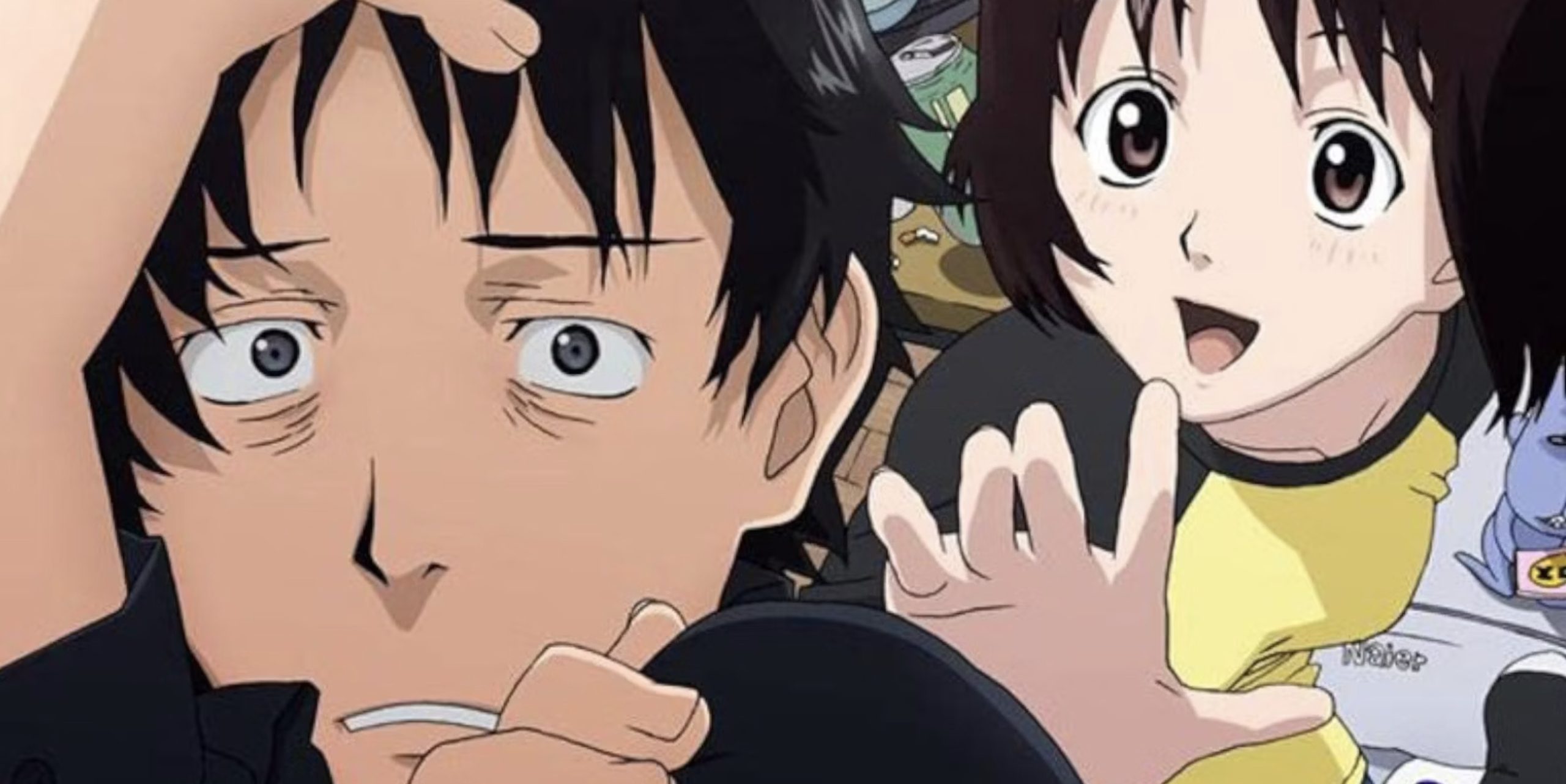
Welcome to the N.H.K. is not a romantic anime in the traditional sense. It doesn’t promise that love will solve mental health struggles. It doesn’t end with a kiss or confession, but with small, believable changes. That’s where its strength lies. It presents an honest portrait of broken people trying to function.
Some may find its pacing slow, and its humor jarring in the context of darker themes. But that discomfort is intentional. It asks viewers to sit with uncertainty, to observe lives that don’t follow scripted resolutions. In that way, it leaves a deeper impact than shows that tie things up with a bow.
This anime stays with you because it reflects truths many are reluctant to confront. It speaks for the overlooked and the lonely without pity. Its message isn’t loud—but it lingers. The act of trying, of failing, of connecting and disconnecting—these are all treated as valid. There’s no final answer, just the courage to keep going.
7. The Wallflower
Tomoko Hayakawa’s manga series serves as the foundation for the amazing anime, The Wallflower. At its core lies the story of Sunako Nakahara, a young girl who retreats into solitude and seclusion after enduring the harsh sting of rejection—being called “ugly” by the first person she confessed her feelings.
This pivotal moment sets the stage for a dramatic transformation in Sunako’s life, as she withdraws from beauty in all its forms, both within herself and the world around her.

Amidst this self-imposed exile, Sunako’s aunt intervenes, extending an invitation for her to reside in a luxurious mansion occupied by four handsome and popular high school boys. Tasked with the seemingly impossible mission of transforming Sunako into a refined lady befitting their elegant abode, the boys begin on a journey that transcends mere physical appearance, delving into the depths of self-esteem and acceptance.
The narrative of The Wallflower intricately weaves together themes of self-perception and personal growth as Sunako and the boys explore the complexities of their cohabitation.
Each boy embodies qualities that Sunako has come to despise, serving as a stark contrast to her own beliefs and values. Yet, through their interactions and shared experiences, they begin to bridge the gap between their disparate worlds, learning valuable lessons about acceptance, empathy, and the true nature of beauty.
As the story reveals, viewers are treated to a dynamic exploration of human relationships, as Sunako and the boys grapple with their preconceived notions and prejudices.
Through laughter, tears, and moments of introspection, they come to understand each other in ways they never thought possible, forging bonds that transcend superficial appearances.
6. Sonny Boy
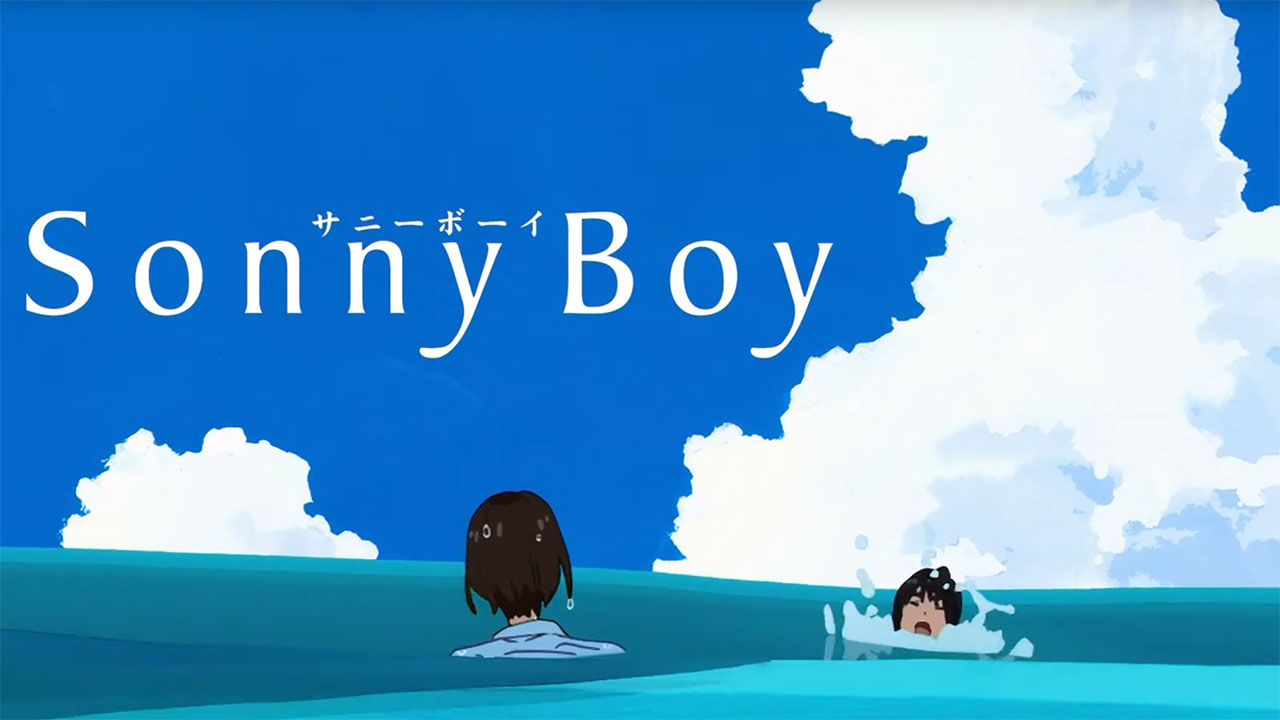
Shingo Natsume brings forth the amazing anime series, Sonny Boy, which reveals a sudden and mysterious event: 36 students, along with their entire school building, are inexplicably transported to a strange dimension.
In the midst of this bewildering situation, they make a startling discovery—each possesses unique and extraordinary powers.
Amidst the backdrop of this surreal setting, Sonny Boy goes into themes of surrealism and science fiction within the framework of a coming-of-age narrative. As the students grapple with the bewildering circumstances thrust upon them, they are confronted with profound questions of identity, individuality, and the nature of reality itself.
The narrative of Sonny Boy transcends mere genre conventions, offering a thought-provoking exploration of the human condition. Against the backdrop of their extraordinary predicament, the students are forced to confront their deepest fears and desires, exploring a complex social platform that is reshaped by their newfound abilities.
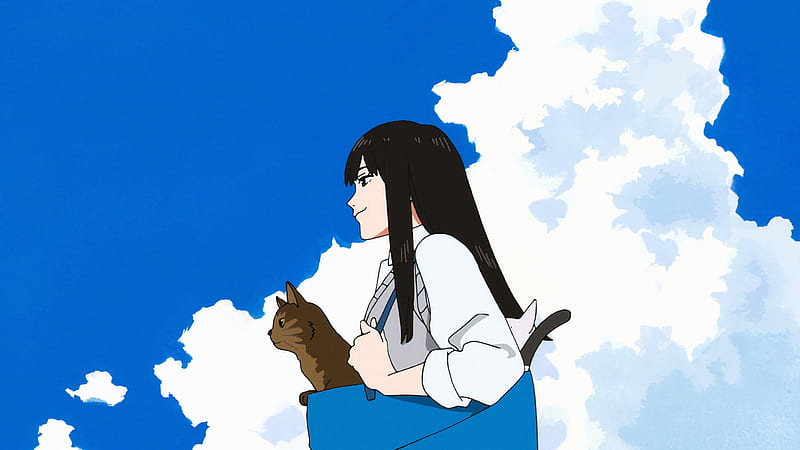
As the story reveals, viewers are drawn into an amazing journey of self-discovery and existential contemplation.
Through the eyes of its protagonists, Sonny Boy sheds light on the universal struggles of adolescence, presenting a poignant reflection on the complexities of identity and the search for meaning in an uncertain world.
Sonny Boy begins with a strange quiet. A group of high school students suddenly finds themselves adrift, their school building suspended in another space. No adults, no rules, no explanation. What unfolds is not just survival—it’s a dissection of the very idea of identity and purpose, where the questions matter more than any resolution.
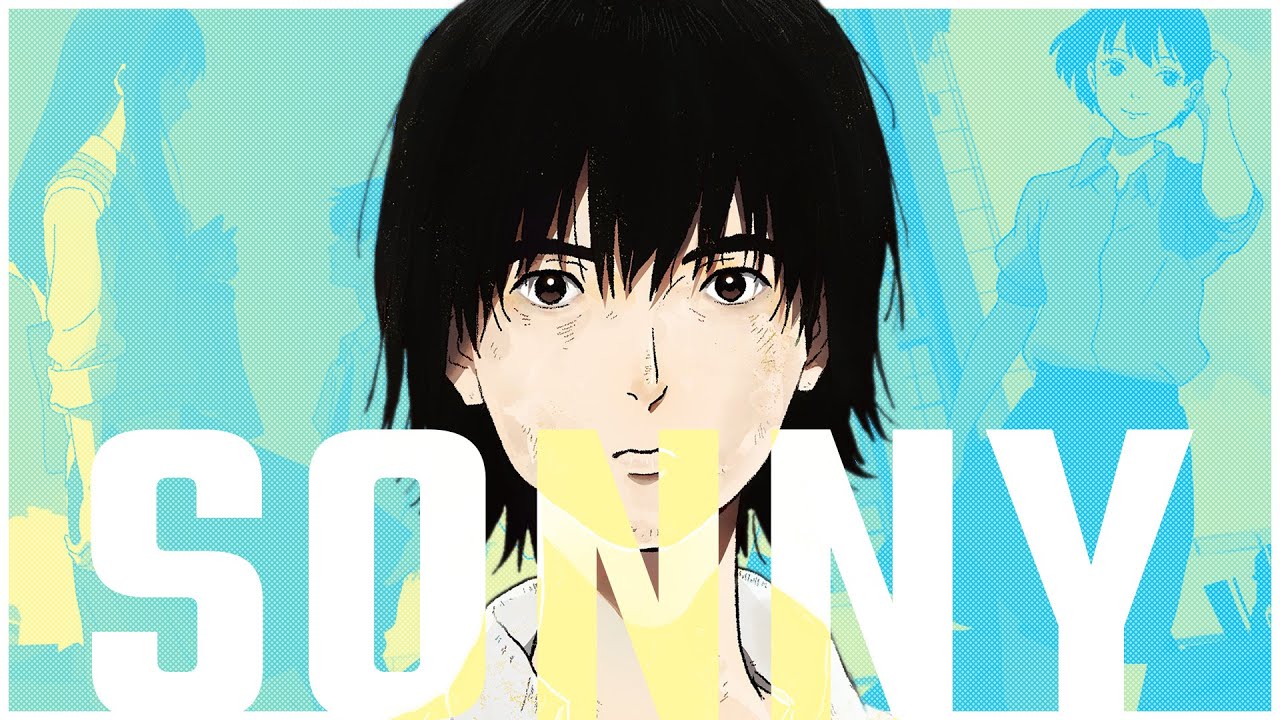
Nagara, the quiet and distant protagonist, becomes the heart of this confusion. His classmates develop powers, each reflecting aspects of their personalities. These abilities are not always helpful—they distort more than they solve. The anime avoids defining these gifts as blessings or curses. They simply exist, like emotions or trauma, to be understood.
Nozomi, bright and unafraid, acts as Nagara’s emotional compass. Her optimism isn’t naive—it’s an anchor in a floating world. Her refusal to yield to fear contrasts with the breakdown of order happening around them. Their connection isn’t romantic in a conventional sense. It’s two souls recognizing each other in a place where nothing else feels real.
As the students travel through different “worlds,” each one acts as a metaphor. Some dimensions amplify isolation, others mirror societal control. The rules change, but the emotional stakes stay consistent. The class fractures—not just physically, but ideologically. Conflicts arise about leadership, justice, and control. It mirrors adolescence itself: chaotic, confusing, full of half-understood feelings.
What sets Sonny Boy apart is its patience. The story never rushes to explain itself. It trusts the audience to sit with silence, to watch expressions, to guess motives. This can feel alienating—but it’s also rare. Anime often fills every moment with dialogue or action. Here, stillness says just as much.
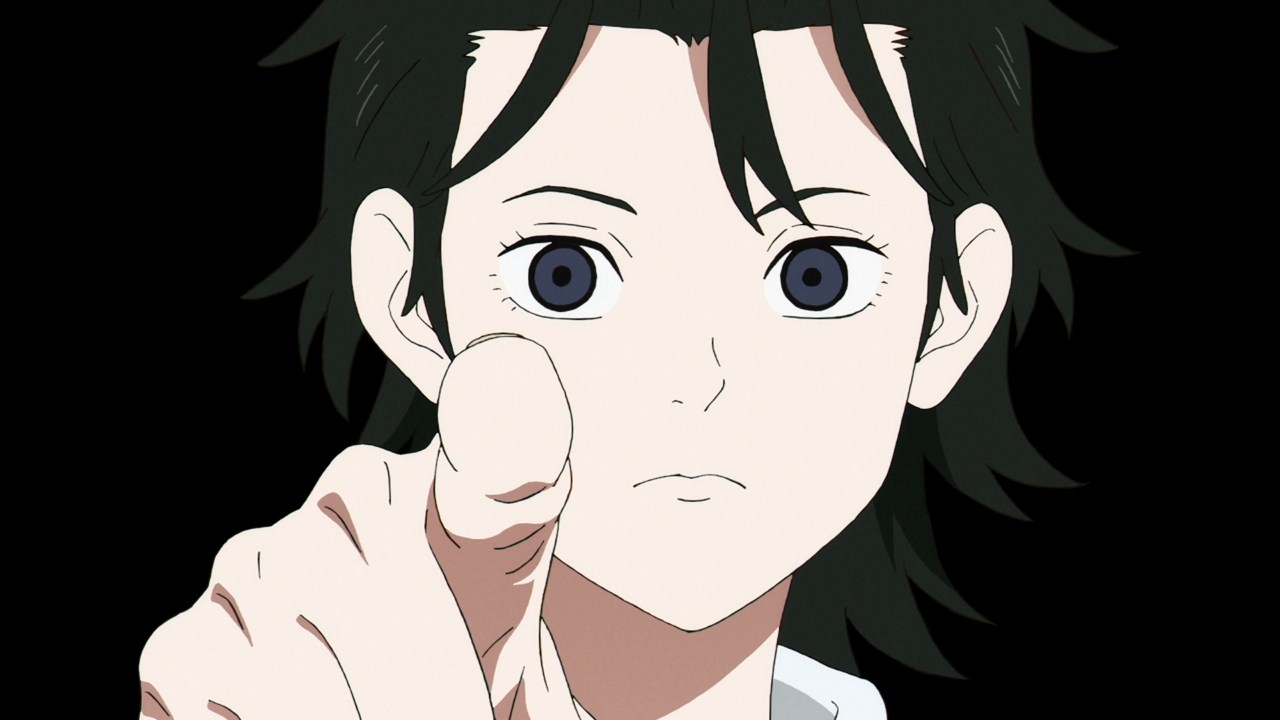
Director Shingo Natsume’s choices reflect deep restraint. He avoids visual excess. Characters are drawn with muted realism, backgrounds often sparse or symbolic. The use of lighting and framing suggests more than it shows. There’s no musical score where you expect one. Instead, moments stretch in near-silence. It builds unease, reflection, and meaning.
The writing resists neat structure. There are no typical arcs—no clean starts, middles, or conclusions. A character might vanish, not die, just… leave. Others remain, but change subtly. Even big reveals arrive quietly. The show refuses to shout. It’s the viewer who must do the heavy lifting, making sense of each dimension’s message.
By the time we reach the midpoint, the themes grow heavier. Friendship becomes a test, trust frays, and the concept of returning “home” becomes less clear. The question shifts from “how do we escape?” to “what are we escaping to?” Many characters don’t want to return to the world they left.
This isn’t just about adolescence—it’s about society. The rules imposed on each new world reflect systems we live under: capitalism, meritocracy, surveillance. Some dimensions function only through blind obedience. Others reward manipulation. The students must either accept these systems or break them, each choice carrying consequences that feel both abstract and painfully personal.
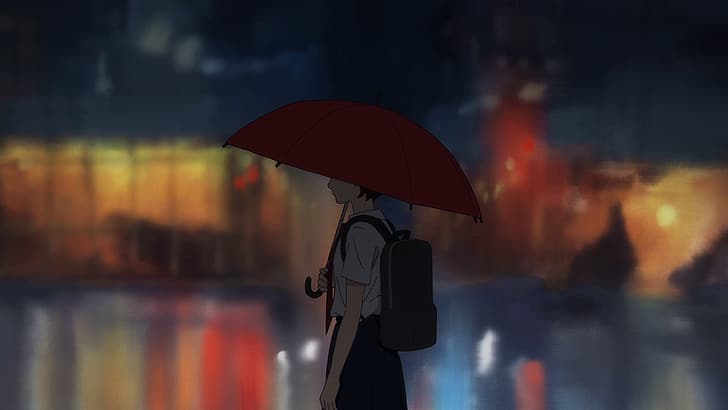
The anime doesn’t offer heroes or villains. Characters like Rajdhani and Mizuho aren’t easy to classify. Their actions stem from belief, fear, or logic—not from narrative convenience. Everyone has reasons. Some run from loneliness. Others try to impose order. A few just want to disappear. Their decisions rarely lead to triumph.
Sonny Boy’s refusal to explain its metaphors frustrates some, but it’s also what makes it linger. A floating classroom. A talking cat. A world where time reverses. These aren’t puzzles to solve—they’re mirrors for thought. Watching the show becomes an exercise in asking why you interpret things the way you do.
Emotionally, the series stays restrained. When big moments happen, they land harder because of this control. One soft conversation by a window can hit harder than a climactic battle. When Nozomi shares her hopes, or when Nagara finally speaks his mind, there’s weight behind every word.
The final episodes don’t tie everything up. In fact, they unravel more than they resolve. But there’s a shift in tone—an acceptance. Nagara, once withdrawn, begins to make choices. He stops waiting for rescue and starts shaping his own future. It’s subtle but feels earned after so much stillness.
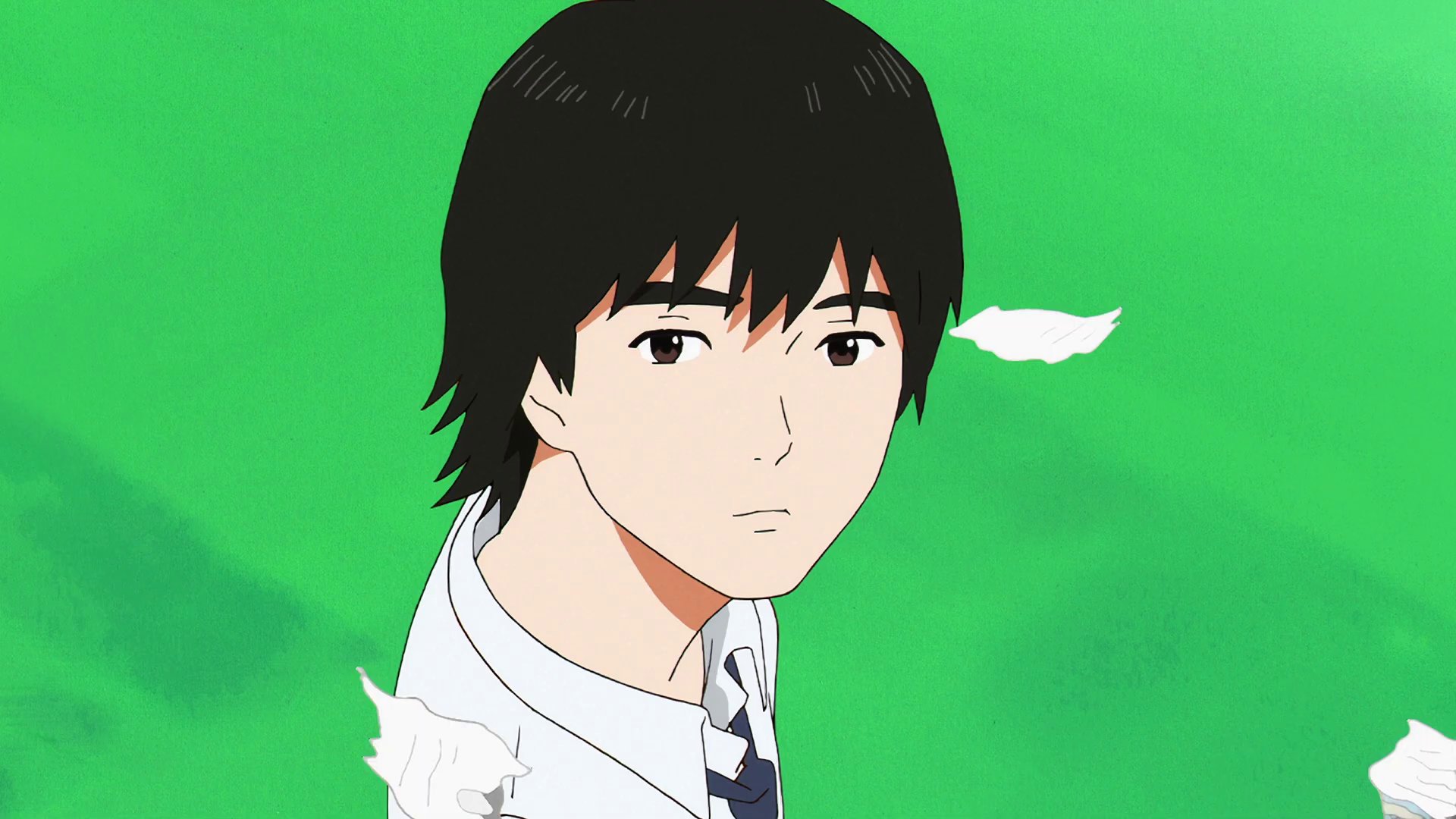
The animation style might not appeal to everyone. It lacks flash or polish. But its raw, almost unfinished quality works in its favor. There’s a handmade, personal feel to each frame. It’s not trying to please—it’s trying to express something delicate and true, even if it’s hard to define.
Music enters sparingly, often through diegetic sound or abstract compositions. The opening theme never arrives, and the ending tracks vary. This unpredictability strengthens the series’ atmosphere. You’re never sure when you’re meant to feel comfort or unease. It’s a reminder that feelings can’t be scheduled.
The audience for Sonny Boy is specific. It’s not for viewers craving answers or action. It’s for those who want to examine the questions behind the questions. Those willing to sit with uncertainty, with characters who don’t know themselves, in a world that may never be explained.
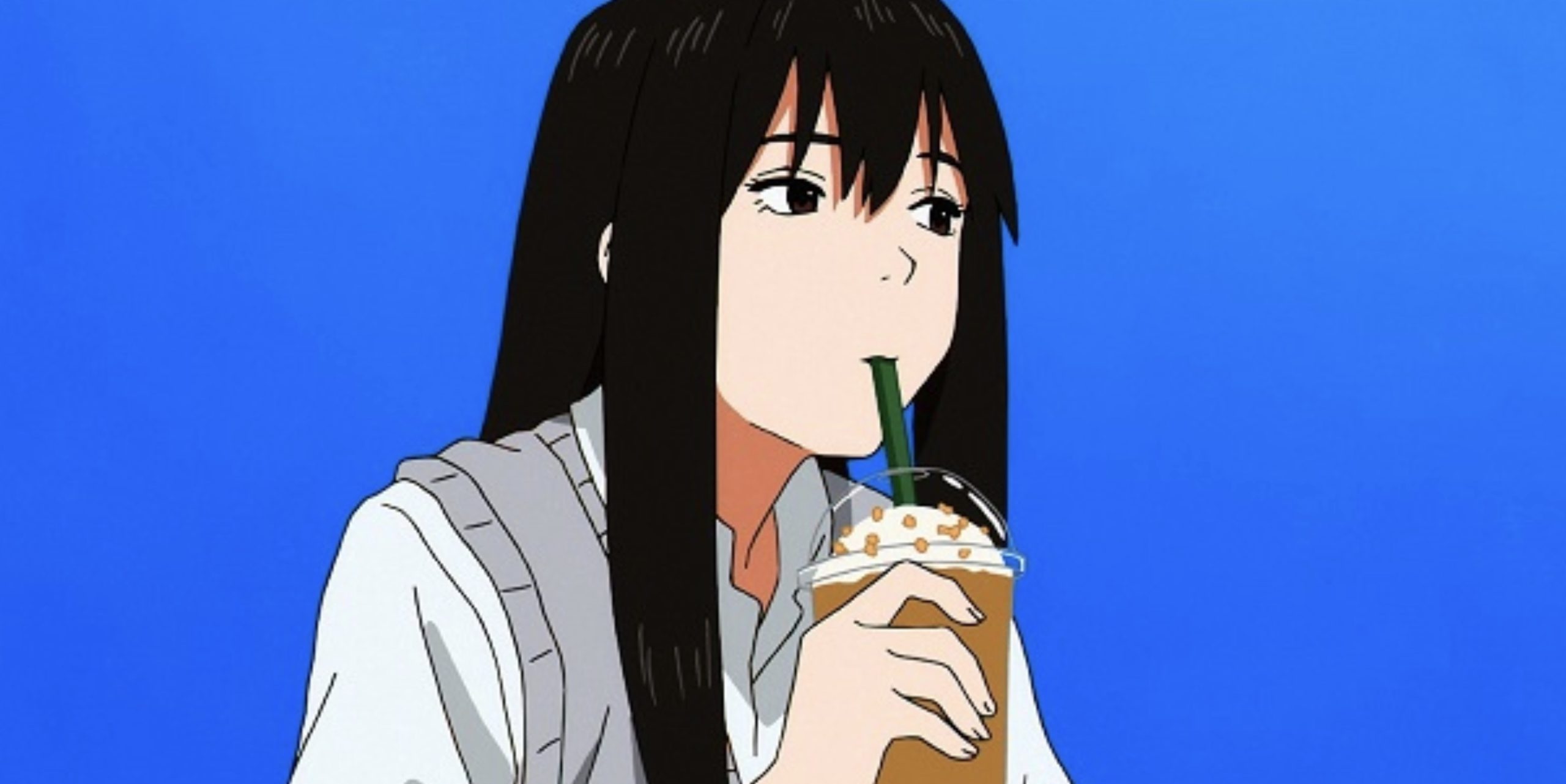
Yet, there’s something universal in it. Everyone has felt lost in a system. Everyone has looked for meaning in moments that didn’t seem to matter. Sonny Boy takes those feelings and spins them into a visual form—without simplifying, without offering false comfort.
The character arcs are uneven but intentional. Not everyone grows. Not everyone learns. And sometimes, that’s the point. Growth isn’t guaranteed. Understanding doesn’t always arrive. But the act of trying still matters. In this way, Sonny Boy reflects real life more than most stories ever attempt.
Even long after finishing the series, specific moments remain vivid. A silent sunset. A shared look. An abandoned island. They don’t explain themselves, but they feel right. They stay with you because they weren’t designed just to entertain—they were built to echo.
5. 5 Centimeters Per Second

In the poignant anime film, 5 Centimeters Per Second, viewers are invited to begin on a soul-stirring journey through the life of a young man named Takaki Tono. Spanning childhood to adulthood, the film reveals three distinct stories, each bearing its own title and delving into profound themes of love, time, and space.
The title itself, “5 Centimeters Per Second,” serves as a poignant metaphor, referring to the gentle descent of cherry blossoms—a delicate reminder of the gradual drifting apart of those held dear. Through the eyes of Takaki, audiences are transported to pivotal moments in his life, where the intricate of love, admiration, and separation is revealed before them.
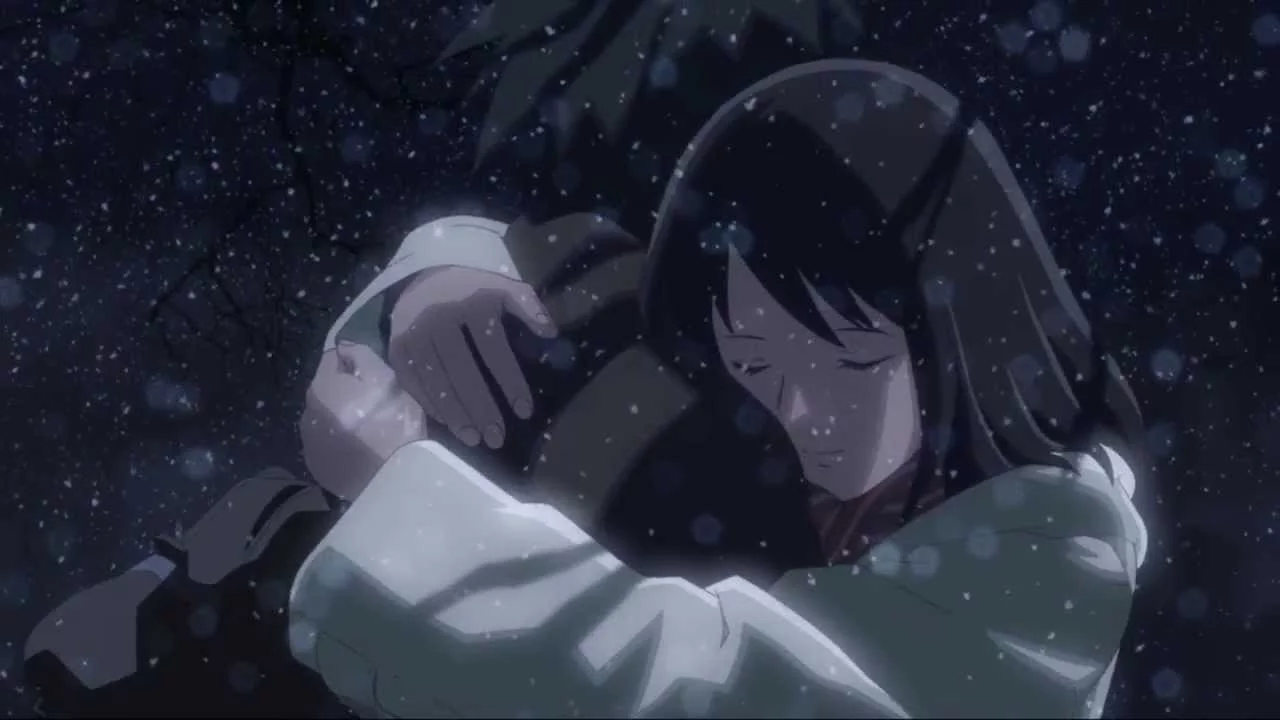
Across each segment, viewers witness Takaki grappling with the complexities of human connection, as love intertwines with the passage of time. From fleeting encounters and unspoken feelings to the bittersweet ache of separation, the film masterfully captures the essence of longing and the inevitability of change.
As Takaki explores the ebbs and flows of his relationships, viewers are granted intimate peeks into his innermost thoughts and emotions. Through moments of introspection and self-reflection, Takaki comes to confront the profound impact of his experiences, shaping the person he becomes as adulthood beckons.
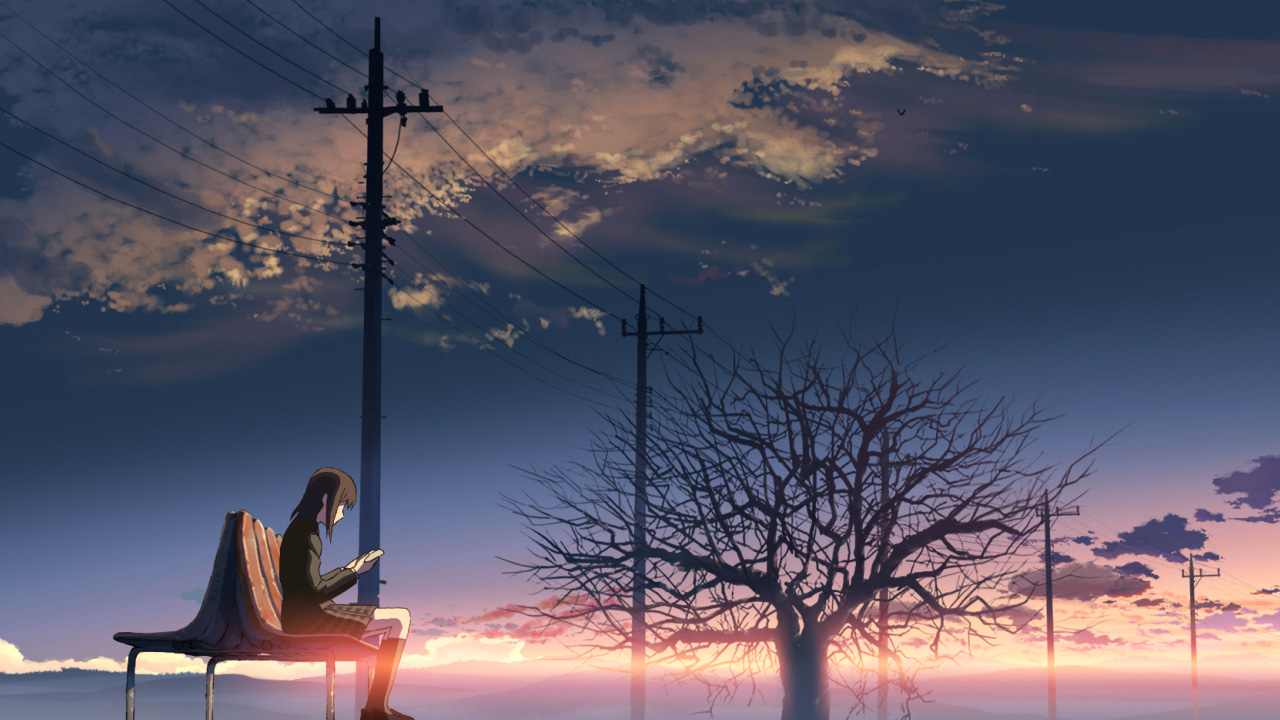
The first chapter, “Cherry Blossom,” sets the foundation of Takaki and Akari’s relationship. Their bond forms in childhood, blooming softly through shared memories and mutual understanding. When Akari moves away, their letters become lifelines. This portion handles the innocence of young love and the struggle of staying close while growing apart. Takaki’s journey to see her captures the ache of waiting.
Snow falls relentlessly during Takaki’s long train ride. Delays, silence, and the sense of missing time heighten his anxiety. The train scenes move slowly, echoing the pain of anticipation and powerlessness. Shinkai lets the environment speak. Lights blur, snow thickens, and we feel how hard it is for connections to survive life’s pace and barriers.
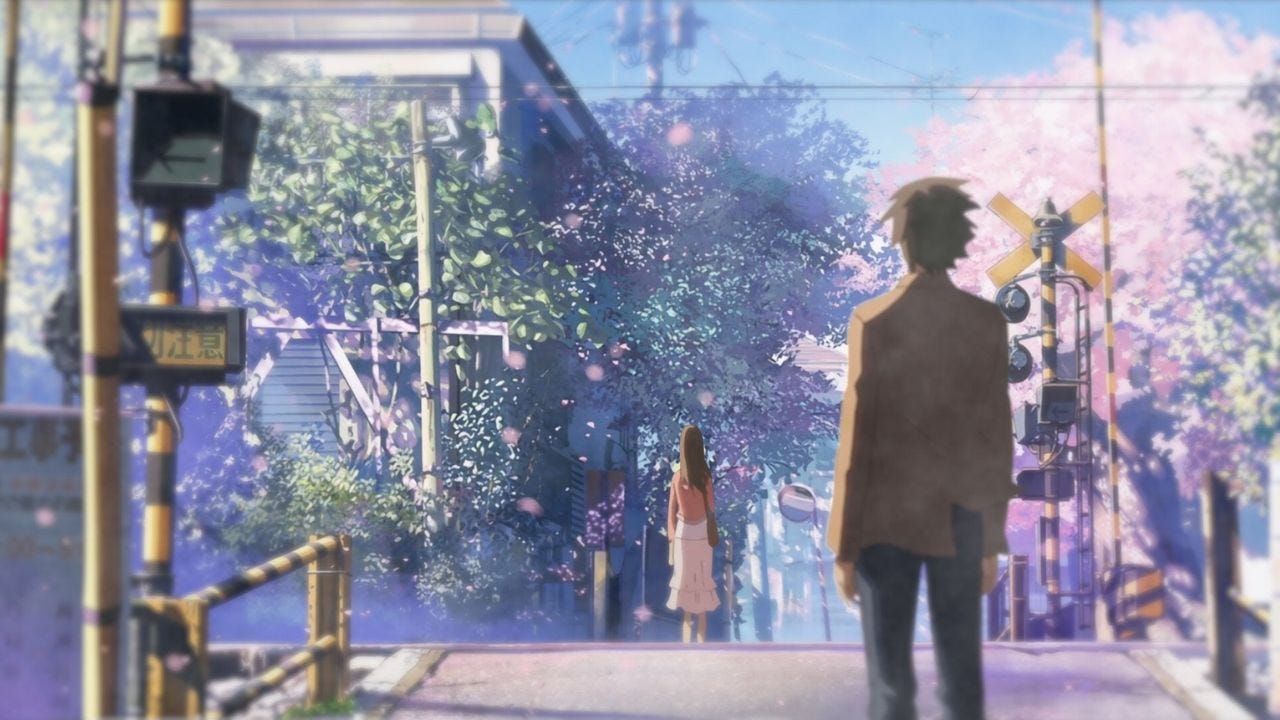
Their reunion feels tender yet heavy. Neither knows how to hold on to the moment, yet they try. They kiss under a quiet shed, surrounded by drifting snow. Nothing is resolved, but it doesn’t have to be. This brief meeting isn’t a turning point—it’s a farewell masked as a promise. That subtlety makes the film emotionally honest.
In “Cosmonaut,” time has passed. Takaki is in high school, and Kanae, a classmate, grows fond of him. Her feelings are sincere, yet her presence emphasizes Takaki’s emotional absence. He remains tethered to Akari’s memory, unable to return Kanae’s affection. The chapter speaks to those left waiting—not for love, but for someone to be emotionally available.
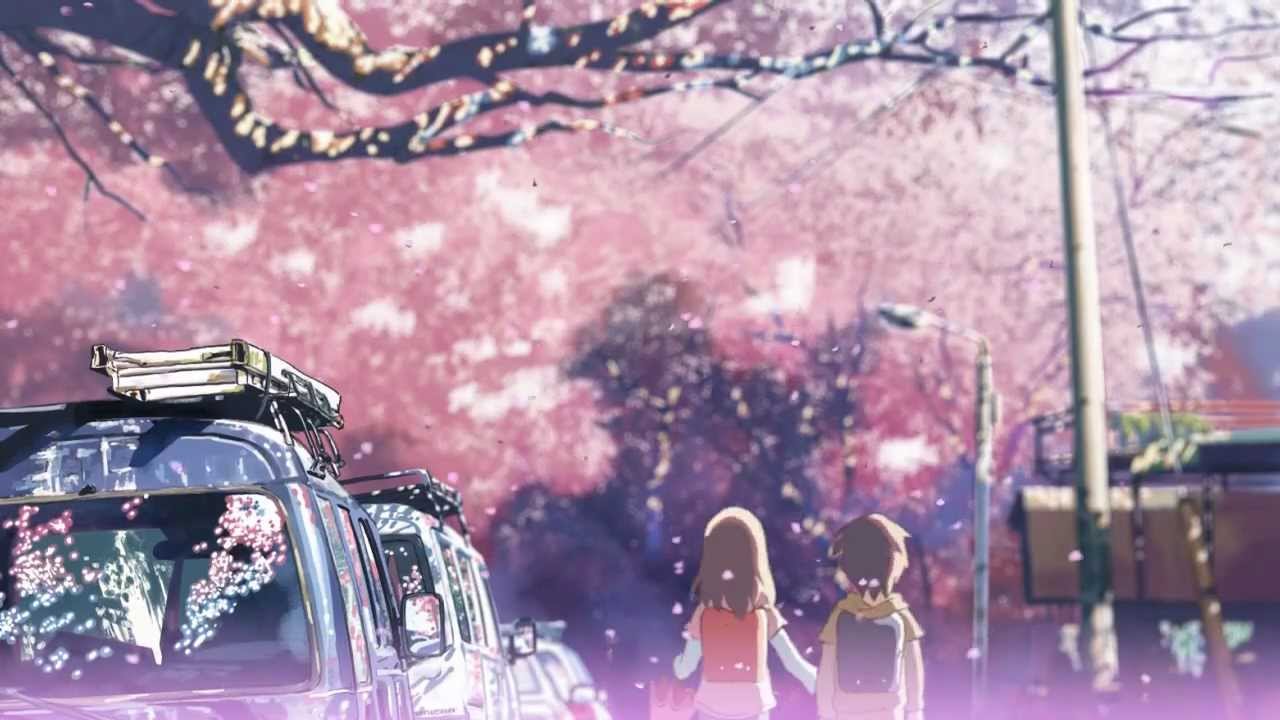
Kanae’s inner conflict is deeply relatable. Her self-doubt, her hesitation to confess, her desire to be understood—all of it feels grounded. The way she rides waves on her surfboard mirrors her feelings. She rides forward, unsure of where she’ll land. Her silence at the end, choosing not to speak her heart, reflects a maturity shaped by acceptance.
Takaki’s detachment becomes clearer in the final segment, “5 Centimeters Per Second.” Now an adult, he moves through life mechanically. He’s successful on paper, but hollow inside. Messages go unanswered. Relationships fade. Akari has moved on. He hasn’t. The simplicity of scenes—train stations, emails, long walks—amplifies the dissonance between the heart’s past and the present’s reality.
A short montage closes the film. Memories flash, songs play, seasons pass. Takaki and Akari, once so close, now live parallel lives. The famous crossing scene, where they briefly see each other but don’t speak, captures the film’s soul. The train hides their glance. When Takaki turns back and she’s gone, he smiles—a gesture of quiet closure.

Shinkai’s style is restrained yet rich. He avoids dramatic confrontations, focusing instead on moments between moments. A falling petal. A slow email reply. A paused glance. These details allow emotion to breathe. The film doesn’t instruct us on how to feel; it simply reflects how time softens, distorts, and often erases what we thought was lasting.
Visually, 5 Centimeters Per Second is stunning. Each frame resembles a painting, whether it’s cityscapes glowing at dusk or rural train stations bathed in snowfall. The precision of the background work contrasts with the quiet simplicity of the characters. That contrast deepens the loneliness. Life moves on, even when hearts do not.
The soundtrack supports the film’s understated tone. Piano notes linger. Ambient sounds fill pauses. The closing song, “One More Time, One More Chance,” mirrors Takaki’s unresolved longing. It’s not just a song—it’s an extension of his inner voice. The lyrics and melody echo the film’s emotional rhythm: tender, wistful, and unresolved.
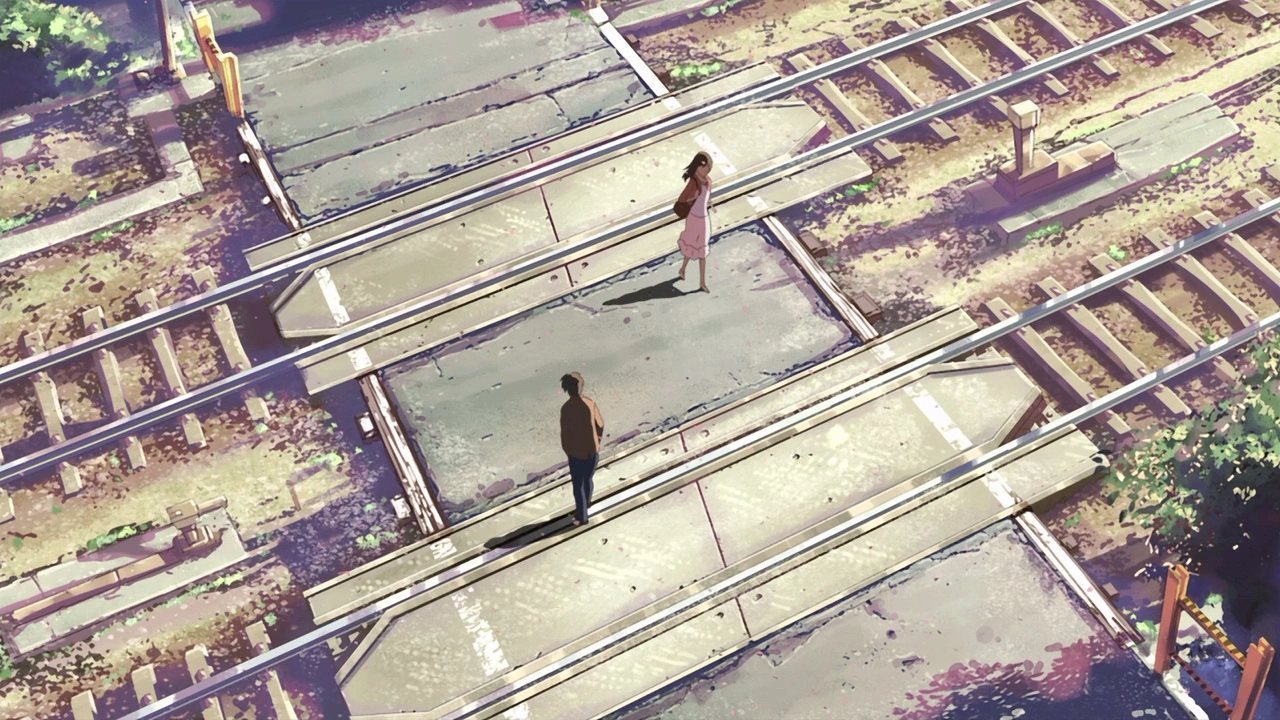
What makes this film resonate is not its plot but its honesty. Relationships aren’t always defined by clear beginnings or endings. Sometimes, they fade. Sometimes, they’re held onto too long. The emotional silence between people often says more than words. Shinkai understands this, allowing scenes to rest quietly in their own emotional weight.
Takaki isn’t a character you root for in a traditional sense. He represents the part of us stuck in the past, too nostalgic to move on. Akari, on the other hand, accepts the passage of time. Her growth contrasts his stagnation. They were once each other’s world, but worlds shift. That shift is life.
The title refers to the speed at which cherry blossoms fall. That slow descent captures the film’s rhythm—gentle, inevitable, and mournful. Just as petals drift apart from the same tree, so do people. They don’t break suddenly. They simply drift, until they no longer share the same space, time, or dreams.
Many stories focus on love fulfilled or heartbreak through betrayal. 5 Centimeters Per Second avoids both. It rests in the middle, where nothing dramatic happens, but everything still hurts. The soft unraveling of closeness, the way absence echoes louder than presence—that’s where its strength lies. It speaks without needing to explain itself.
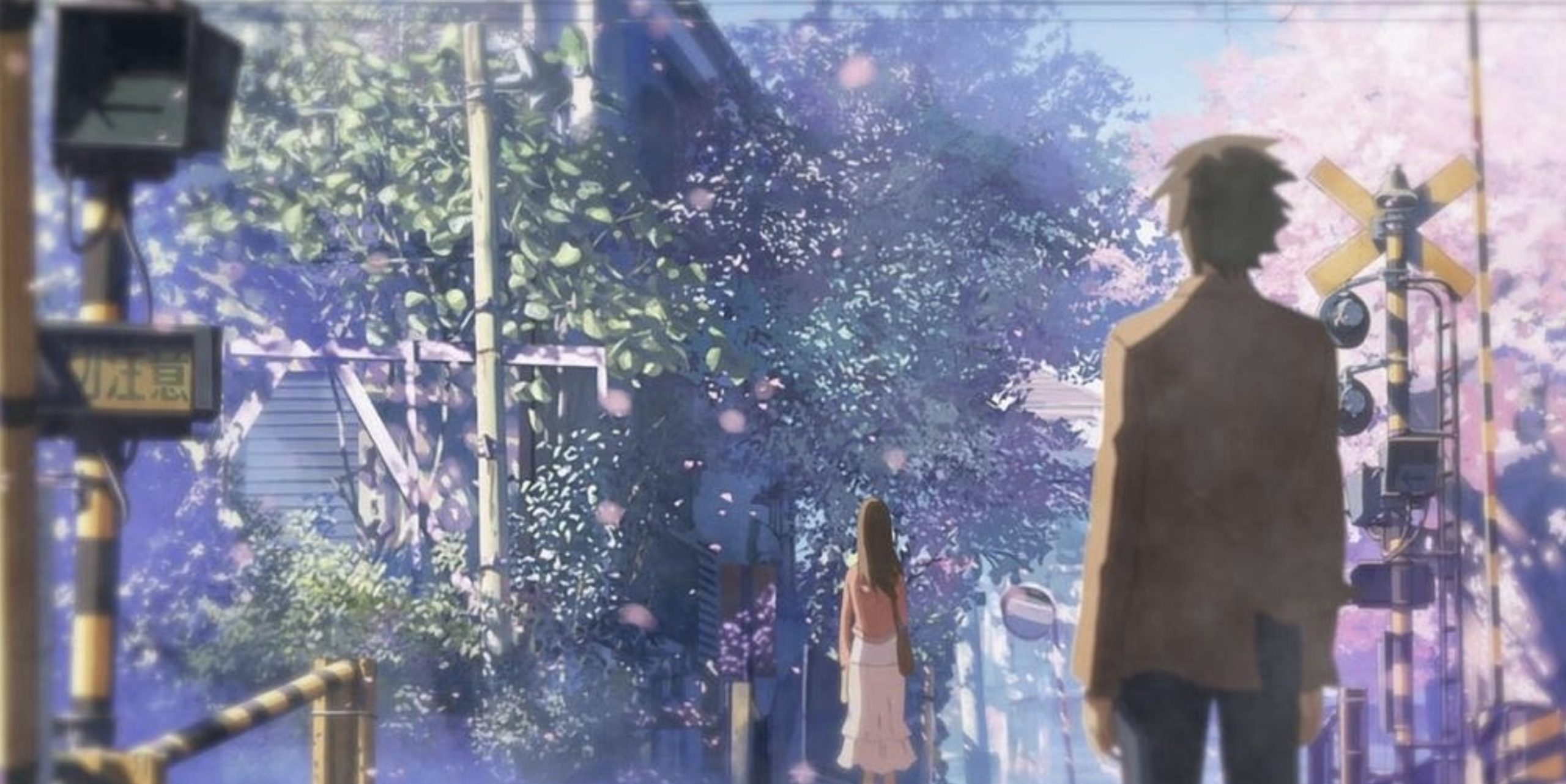
There’s beauty in unresolved emotion. The film doesn’t force conclusions. It reflects real feelings—ones that linger, that don’t wrap up neatly. For some, that can feel frustrating. But for others, it brings a kind of comfort. A reminder that even unfinished stories have worth, that feelings don’t always need to be validated by outcome.
5 Centimeters Per Second leaves space to reflect on your own experiences. Moments when distance, time, or silence shaped your connections. Times when you waited for a message that never came. Times when you remembered someone who didn’t remember you. The film doesn’t fix those wounds, but it acknowledges them with grace.
What remains after the film ends is not a memory of what was said but what was felt. That aching stillness. That recognition that not all love is meant to last, but it can still matter. 5 Centimeters Per Second is quiet, but in its silence, it says everything it needs to.
4. My Teen Romantic Comedy – SNAFU
At the heart of the romantic comedy anime, My Teen Romantic Comedy – SNAFU, lies the story of Hachiman Hikigaya, a high school student steeped in cynicism and isolation.
With a skewed perspective on life, Hachiman finds himself devoid of meaningful connections, exploring the corridors of high school without friends or relationships to anchor him.
His disdain for modern social norms is laid bare in an essay that mocks the intricacies of human interaction, thrusting him into an unexpected turn of events.

Forced to join a volunteer service club as a form of retribution, Hachiman encounters Yukino Yukinoshita, an amazing figure whose beauty and intellect belie her own struggles with solitude.
Together, they form an unlikely trio alongside the cheerful and effervescent Yui Yuigahama. As they begin their altruistic endeavors, exploring the complexities of teenage life, they find themselves entangled in a web of interpersonal relationships and emotional entanglements.
Throughout the series, My Teen Romantic Comedy – SNAFU deftly explores the lives of its protagonists, shedding light on the issues faced by the individuals they encounter.
From grappling with loneliness and yearning for connection to exploring the treacherous waters of romance and understanding, the trio confronts a myriad of challenges with humor and occasional seriousness.
As the narrative reveals, viewers are treated to a blend of comedic escapades and poignant moments, delving into the depths of teenage angst and the quest for self-discovery.
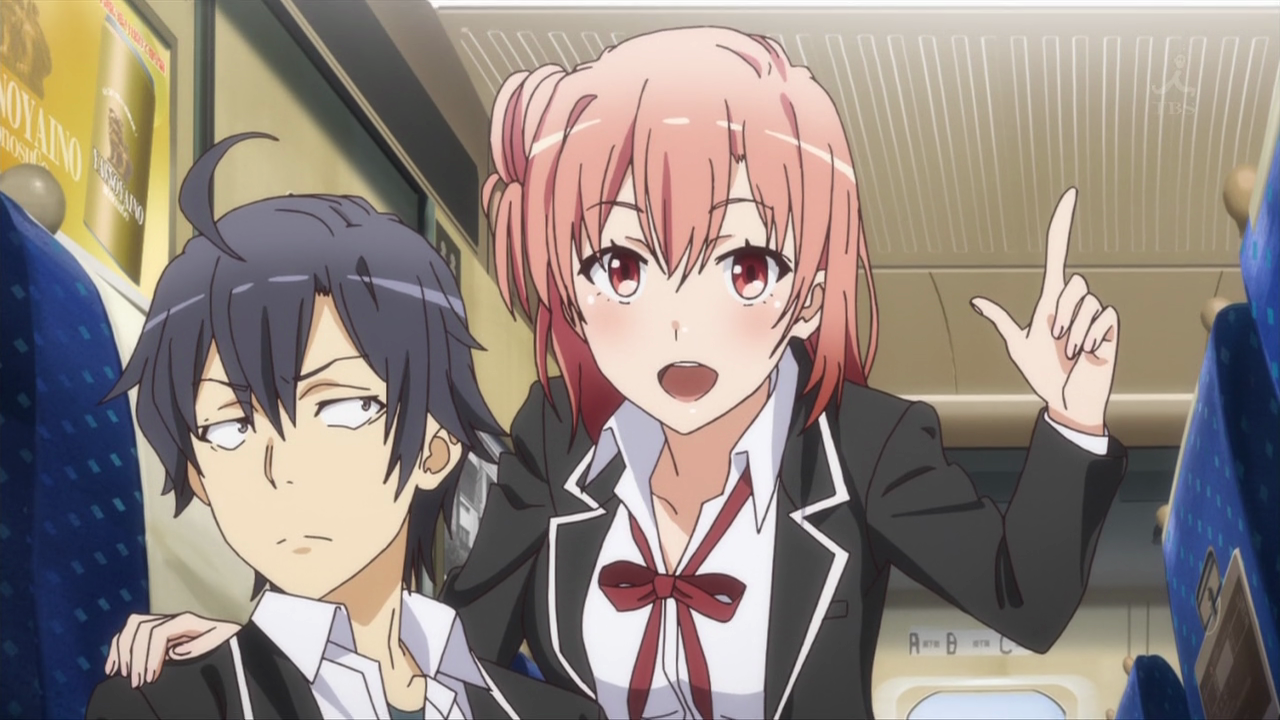
Through their interactions with one another and the students they assist, Hachiman, Yukino, and Yui begin on a journey of personal growth and mutual understanding, forging bonds that defy the constraints of social norms.
My Teen Romantic Comedy SNAFU takes a different route from traditional school romance anime. Rather than focusing on lighthearted situations or obvious romantic developments, the story revolves around deeply personal, often painful, internal conflicts. The series builds its strength on sharp dialogue, psychological realism, and characters who are far from perfect.
The main character, Hachiman Hikigaya, stands out as an isolated observer. He prefers solitude and holds a pessimistic view of social connections, often delivering brutally honest thoughts that echo his emotional scars. His journey isn’t about fitting in or becoming popular but about confronting the pain he hides behind sarcasm.
Yukino Yukinoshita is equally isolated but from a different angle. She is sharp, accomplished, and painfully honest—sometimes coldly so. Yukino’s presence in the Volunteer Service Club adds tension to Hachiman’s world. Unlike him, she embraces confrontation instead of avoidance, creating constant ideological clashes that push both characters out of their emotional corners.
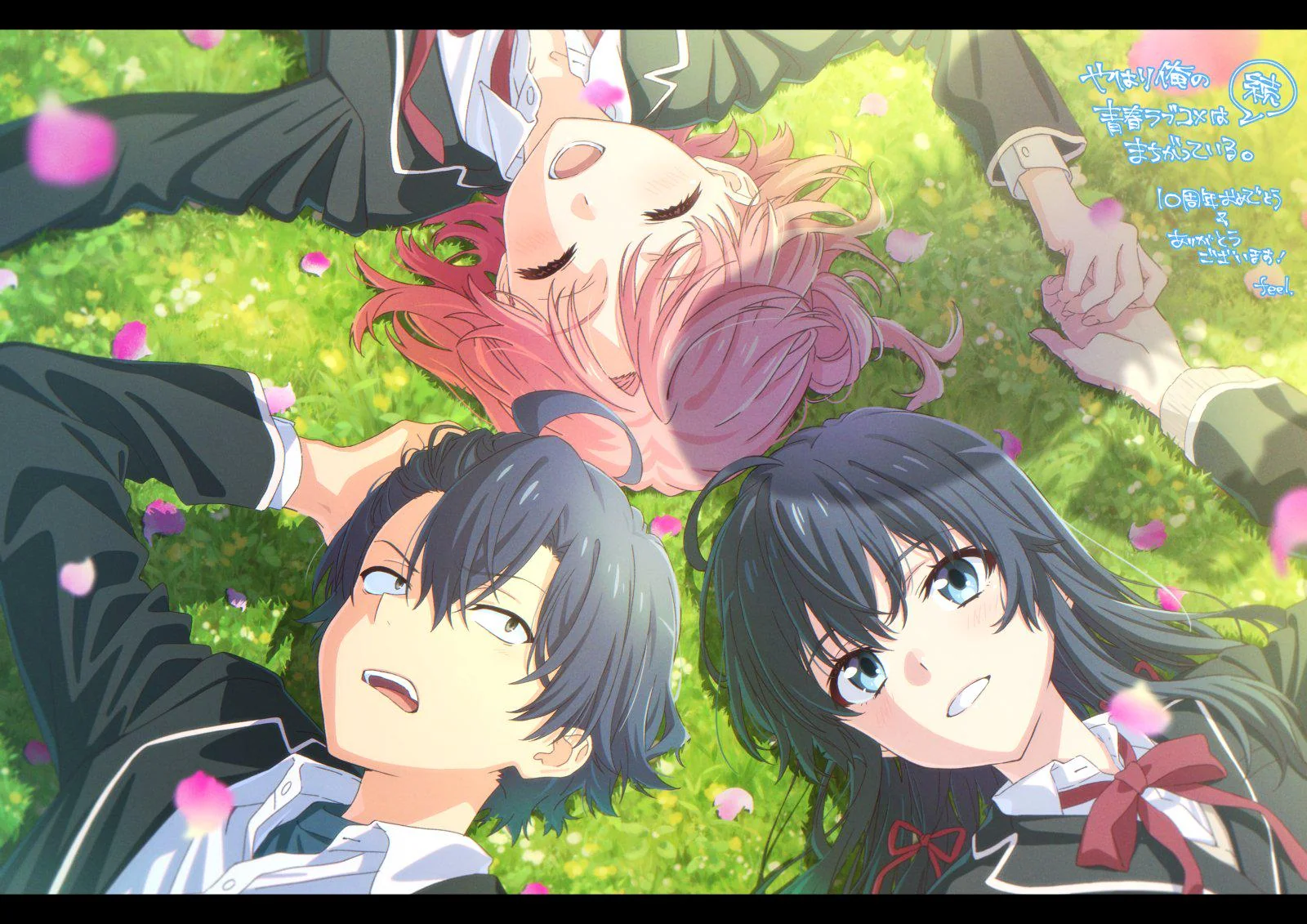
Then comes Yui Yuigahama, the emotional bridge between the two. Yui is bubbly and expressive, but her desire to avoid conflict puts her in difficult positions. She deeply cares for both Hachiman and Yukino, often forcing herself to mediate when things get too intense. Her sincerity offers a counterbalance to the cool detachment of the others.
The Volunteer Service Club becomes a battleground of clashing values. Tasks that appear mundane—like helping classmates with events or social problems—often lead to moral dilemmas. Hachiman prefers practical but harsh solutions. Yukino pushes for idealistic approaches. Yui tries to find middle ground, showing how emotional intelligence plays a role in group dynamics.
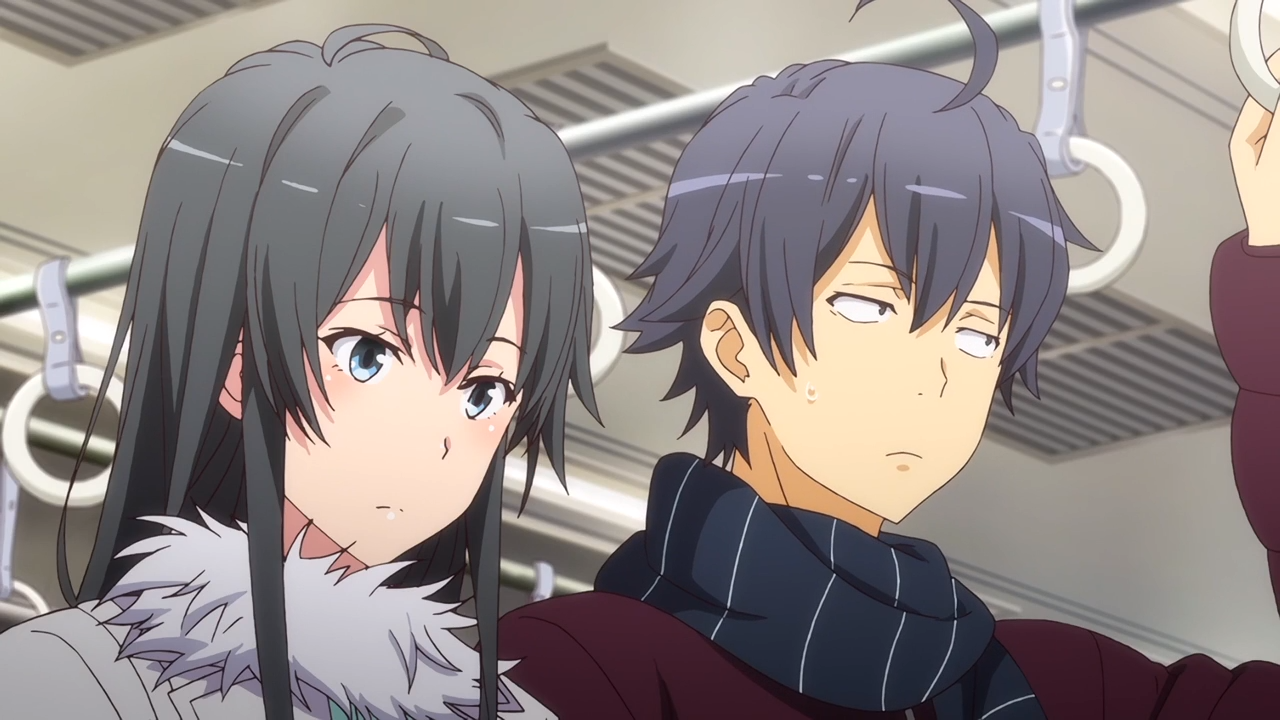
Rather than forcing the characters into traditional romantic arcs, the story lets their emotional struggles unfold naturally. Moments that might be romantic in other shows are often painful here. There’s tension in what’s not said, in glances, silences, and moments of withdrawal. The slow development is part of its charm.
Hachiman’s famous quote, “If you expect nothing, you’ll never be disappointed,” isn’t just edgy sarcasm. It’s a defense mechanism built from rejection and misunderstanding. Throughout the series, he learns that emotional detachment doesn’t protect from pain—it just shifts it inward. This change in perspective is subtle but deeply meaningful.
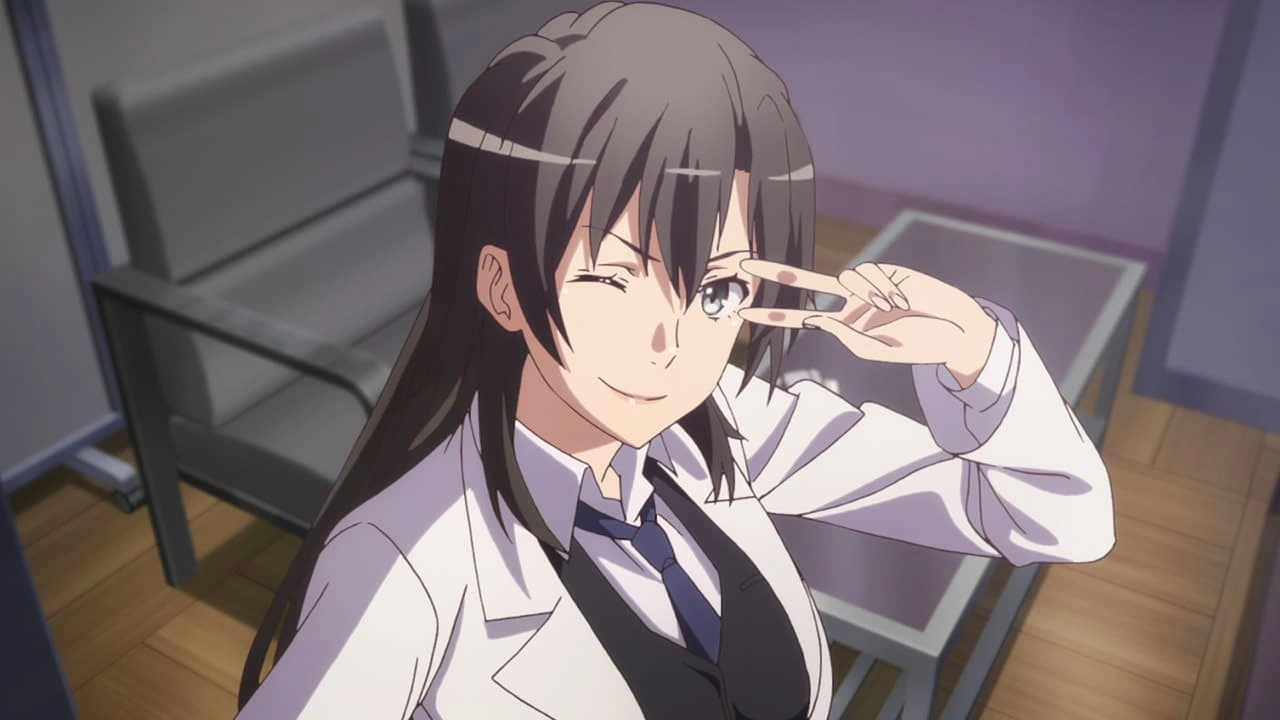
Season two introduces greater emotional complexity. The characters begin to understand how their words and choices affect each other. Hachiman’s actions—intended to shield others—often backfire, creating unintended wounds. The romantic triangle becomes more defined, but not in the expected way. Each character grapples with their growing feelings in different ways.
Yukino’s arc in season two reveals her deep need for independence and recognition. Her pride isolates her, even from those who want to support her. Her struggle isn’t just about romance—it’s about learning to accept vulnerability. Her relationship with Hachiman teeters between respect, rivalry, and unspoken affection.
Yui’s internal battle becomes increasingly poignant. Her cheerful exterior hides an intense desire to stay close to those she loves, even at her own expense. Watching her try to hold the group together, despite knowing she may lose what she wants most, gives her character a touching emotional depth.
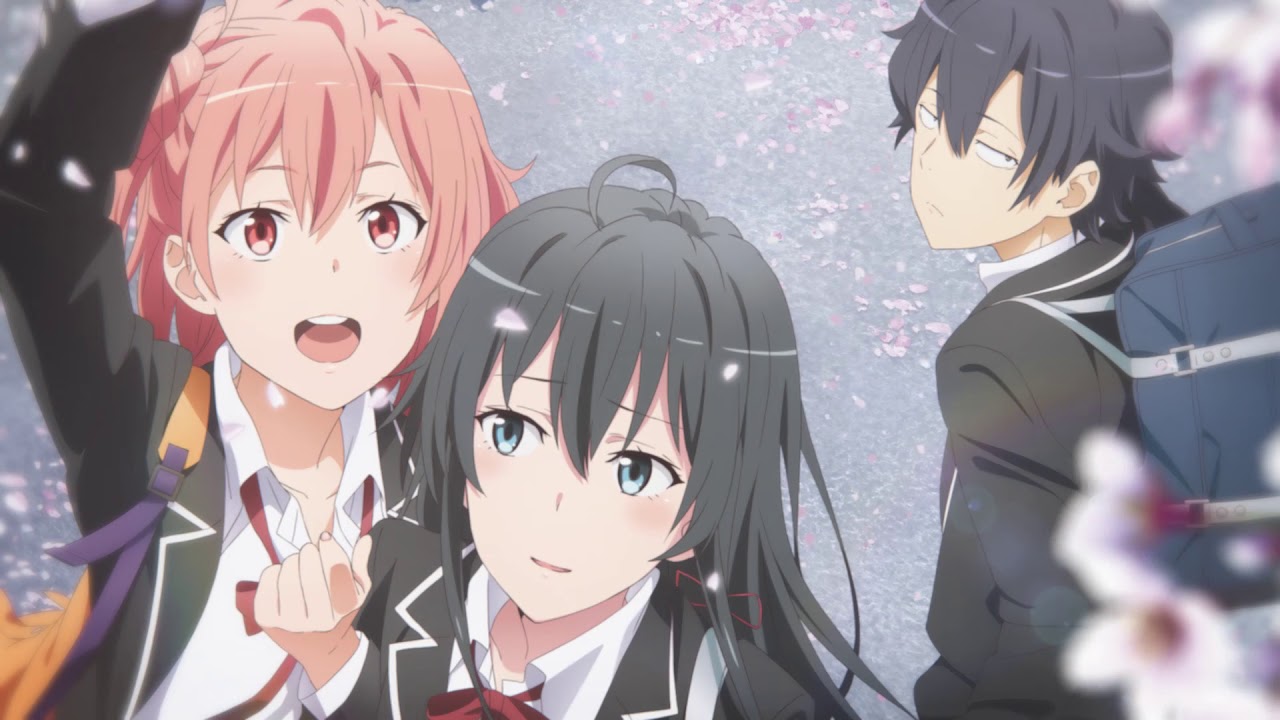
The writing gives ample space for reflection. Characters often sit with their thoughts, allowing the audience to absorb their emotional states without rushed conclusions. The atmosphere leans into stillness—quiet halls, dusk-lit classrooms, and the gentle hum of uncertainty. These spaces feel authentic and personal.
Visual direction subtly mirrors emotional states. Cool tones dominate scenes with conflict or isolation, while warmer lighting appears during fleeting moments of connection. Expressions are carefully drawn, with slight eye movements or hesitations conveying entire emotional shifts. The visuals never distract—they enhance emotional undercurrents.
The soundtrack is understated, often minimal, giving room for dialogue and silence to hold power. Piano melodies and soft string arrangements echo the melancholy themes. The music never leads the emotion—it reflects it. This makes the show’s heavier scenes hit with honest weight, without overplaying the drama.
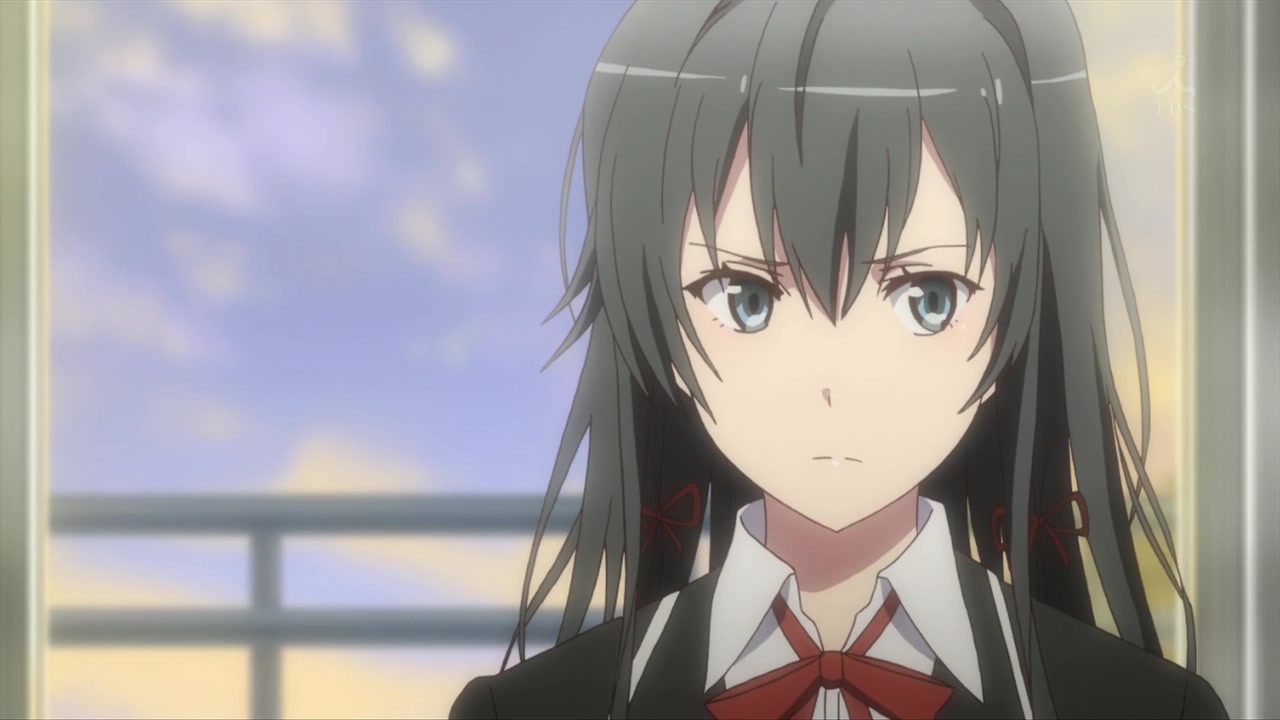
Though labeled a romantic comedy, the humor is often dry, sarcastic, or ironic. Much of it stems from Hachiman’s internal monologues or awkward social moments. It isn’t laugh-out-loud funny—it’s quietly smart. The comedy functions more as commentary than distraction, often highlighting the absurdity of teenage expectations.
The third season continues the emotional payoff. Confessions aren’t dramatic spectacles but soft, tentative gestures. Feelings are revealed in half-formed sentences, in the struggle to express something real without damaging what already exists. It’s these small, quiet moments that leave lasting impressions.
Hachiman’s growth becomes central by the final arc. He starts wanting something “genuine”—not shallow friendships, not performative kindness, but true emotional connection. That search becomes his driving force. The challenge lies in admitting he wants that connection and risking the comfort of solitude to pursue it.

The final episodes leave some emotions unresolved, but that ambiguity works in the anime’s favor. Life doesn’t always offer neat answers. The uncertainty in the characters’ relationships—especially Hachiman and Yukino—feels genuine. What matters is their willingness to keep trying, to keep growing, despite discomfort and fear.
The series doesn’t glamorize romance or youth. It presents adolescence as a period of confusion, fear, and emotional trial. But it also shows how connection—no matter how awkward or slow—is worth the struggle. It speaks to anyone who’s ever felt like an outsider in their own world.
My Teen Romantic Comedy SNAFU is not about winning hearts but understanding them. It’s about how people guard themselves, how honesty can hurt, and how growing close to someone requires letting them see your worst parts. It’s painful, beautiful, and remarkably honest about being young and lost.
3. Serial Experiments Lain
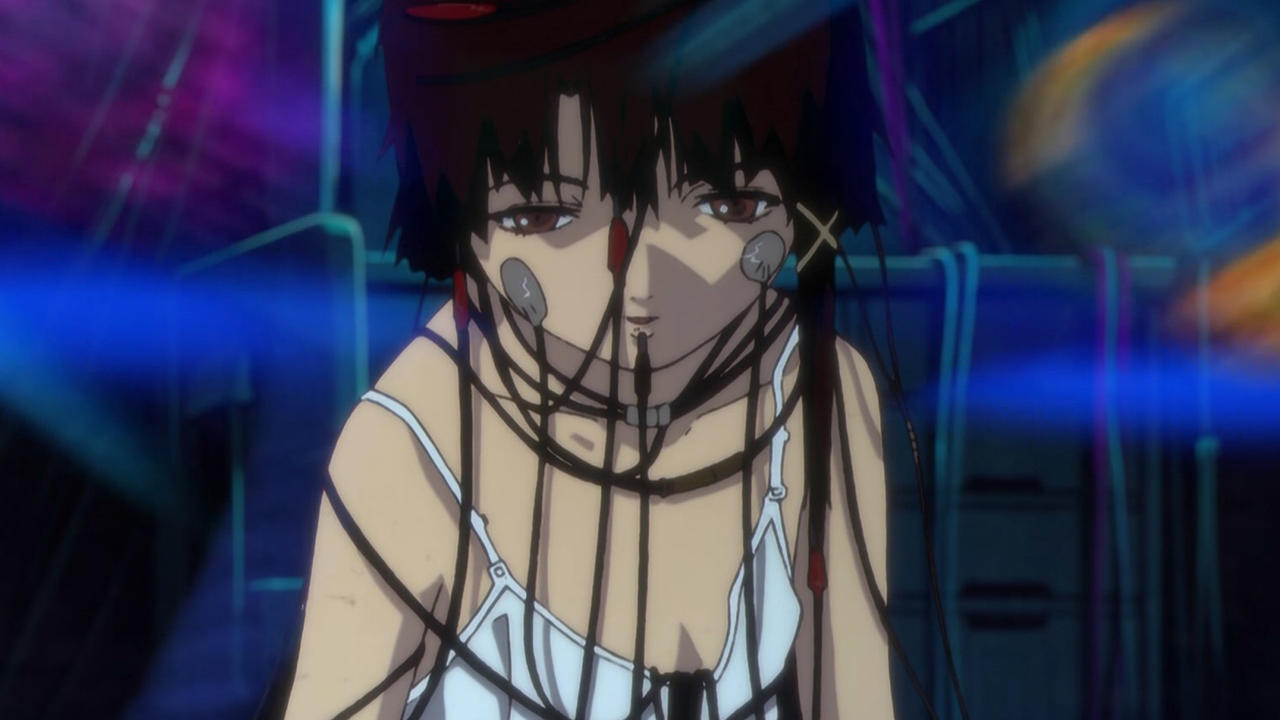
In the atmospheric suburban Japan in the 1990s, Serial Experiments Lain casts a mesmerizing spotlight on the figure of Lain Iwakura—a reserved and introspective young girl whose life takes a profound turn following a fateful email from a classmate who has taken their own life.
With the arrival of this mysterious message, Lain begins on a journey into the depths of the Wired—a sprawling virtual network that blurs the boundaries between reality and illusion.
As she goes deeper into this digital world, strange phenomena begin to be revealed, intertwining the events of the physical world with the ethereal the Wired. In the midst of this convergence, Lain grapples with existential questions and struggles to discern what is real and what is merely a product of the digital domain.
Serial Experiments Lain serves as an amazing exploration of humanity’s relationship with technology and the profound impact of the internet on modern society.
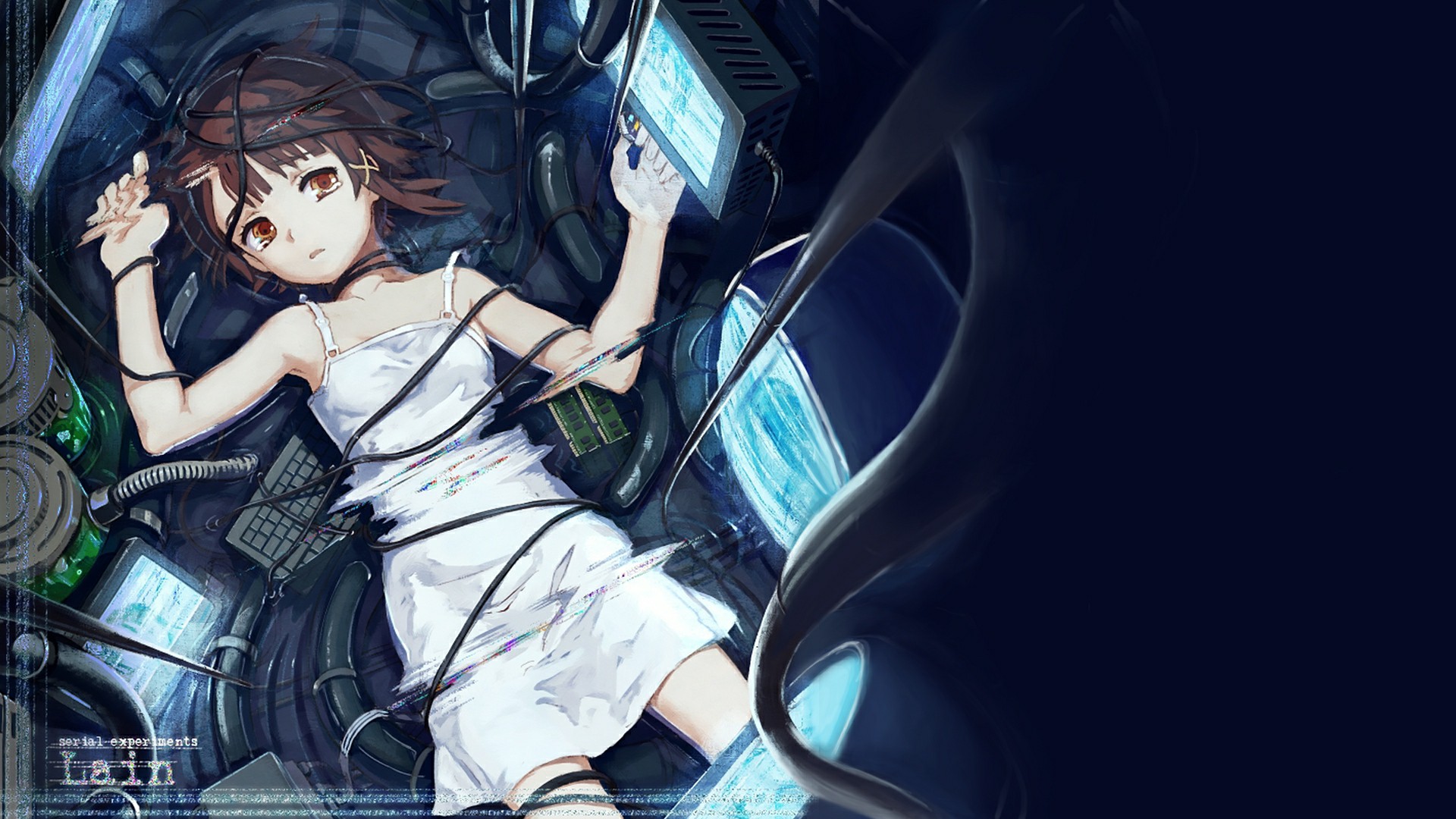
Through its thought-provoking narrative, the series goes into the complexities of identity, consciousness, and the blurred lines between the physical and digital worlds.
At its core, Serial Experiments Lain challenges viewers to confront the existential dilemmas posed by the influence of technology in our lives.
As Lain explores the labyrinthine corridors of the Wired, she confronts the shadowy undercurrents of human nature and grapples with the forces that shape our perceptions of reality.
Lain Iwakura is quiet, withdrawn, and seemingly disconnected from the world around her. At school, she barely speaks. Her classmates don’t pay much attention, and her family behaves like distant strangers. Lain’s home life is stiff, cold, and clinical. The only sign of warmth comes from her growing interest in the Wired—an advanced version of the internet.
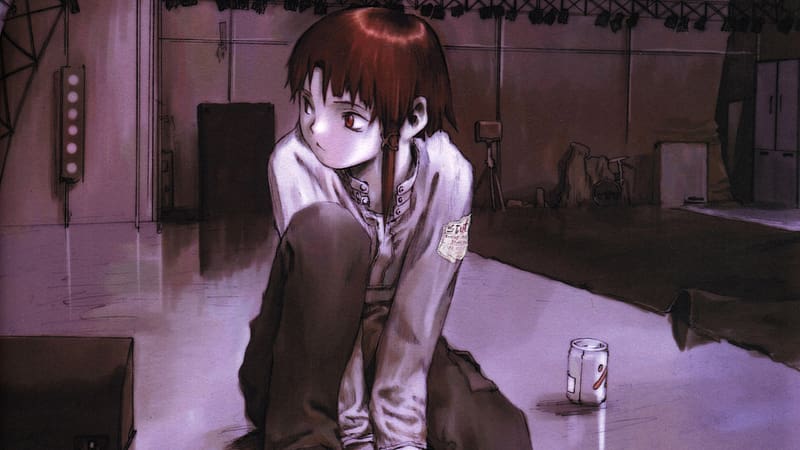
The story begins with a suicide. Chisa, a schoolmate, throws herself from a rooftop. But days later, classmates receive emails from her, claiming she’s not dead but alive within the Wired. Most students dismiss it as a prank, but Lain becomes curious. Something in her shifts, leading her to open up the computer she barely used before.
As she immerses herself deeper into the Wired, Lain’s personality begins to shift. Her social awkwardness melts away, replaced by a calm confidence. A second version of herself appears online—more assertive, more chaotic, and more detached. This digital double causes confusion, even distress. The boundary between her physical self and her digital self starts to erode.
The show poses unsettling questions. Who are we when we’re online? Are we the same people in digital spaces as we are in real life? Is consciousness something fixed, or can it move through networks and information like a current? These questions unfold slowly, surrounded by long silences and haunting electronic hums.
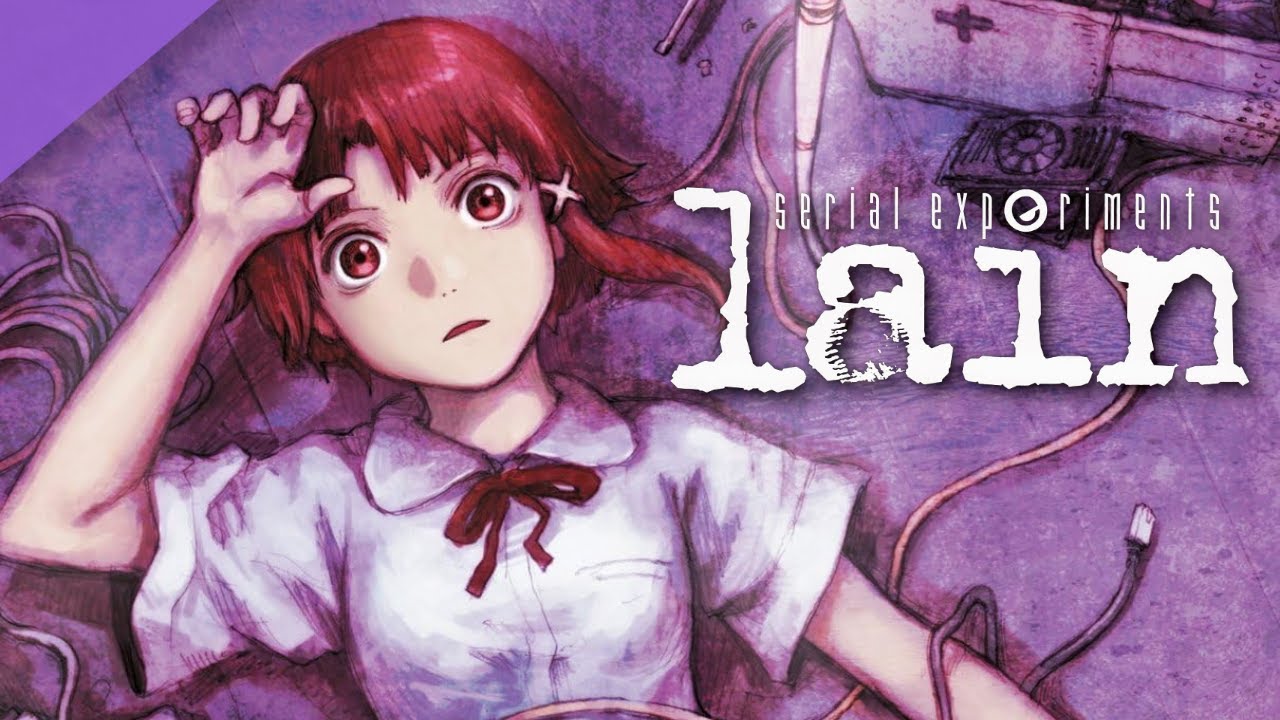
Lain’s world grows more abstract as reality begins to dissolve. Telephone wires buzz with hidden voices. The city itself seems to pulse with invisible data. Strangers begin addressing Lain as someone they already know. Others whisper conspiracies about her nature. The more she investigates, the more the truth becomes fragmented and incomprehensible.
The series uses minimal dialogue and slow pacing to unsettle. Scenes stretch out uncomfortably long. Ordinary moments are interrupted by static, flickers, and glitches. The line between dream and reality blurs. Lain’s room becomes cluttered with wires, computers, and blinking lights—visually mirroring the chaos inside her mind.
As her presence in the Wired grows stronger, Lain uncovers a web of entities controlling information flow. She meets the Knights—a mysterious group trying to reach godhood through data. They see Lain as a central figure, one who can reshape the fabric of communication. But Lain herself still doesn’t know who she is—or what she’s becoming.

Themes of surveillance and digital manipulation run deep. Lain is constantly watched—by others, by technology, by even herself. Her life is no longer her own. Every thought, every movement, becomes part of the Wired. The loss of privacy parallels the modern concern of being reduced to data in a connected world.
Her family begins to fall away. Her sister becomes emotionally unstable. Her father speaks in riddles, hinting that Lain is not really his daughter. Their home disintegrates into silence. These moments aren’t explained—they are meant to evoke a sense of disconnection that mirrors Lain’s descent into the Wired.
The anime never provides clear answers. It resists linear logic. Each episode introduces new fragments of truth, often contradicting what came before. This refusal to resolve makes the experience unsettling. It mirrors the experience of scrolling endlessly through digital spaces, seeking meaning but only finding more noise.
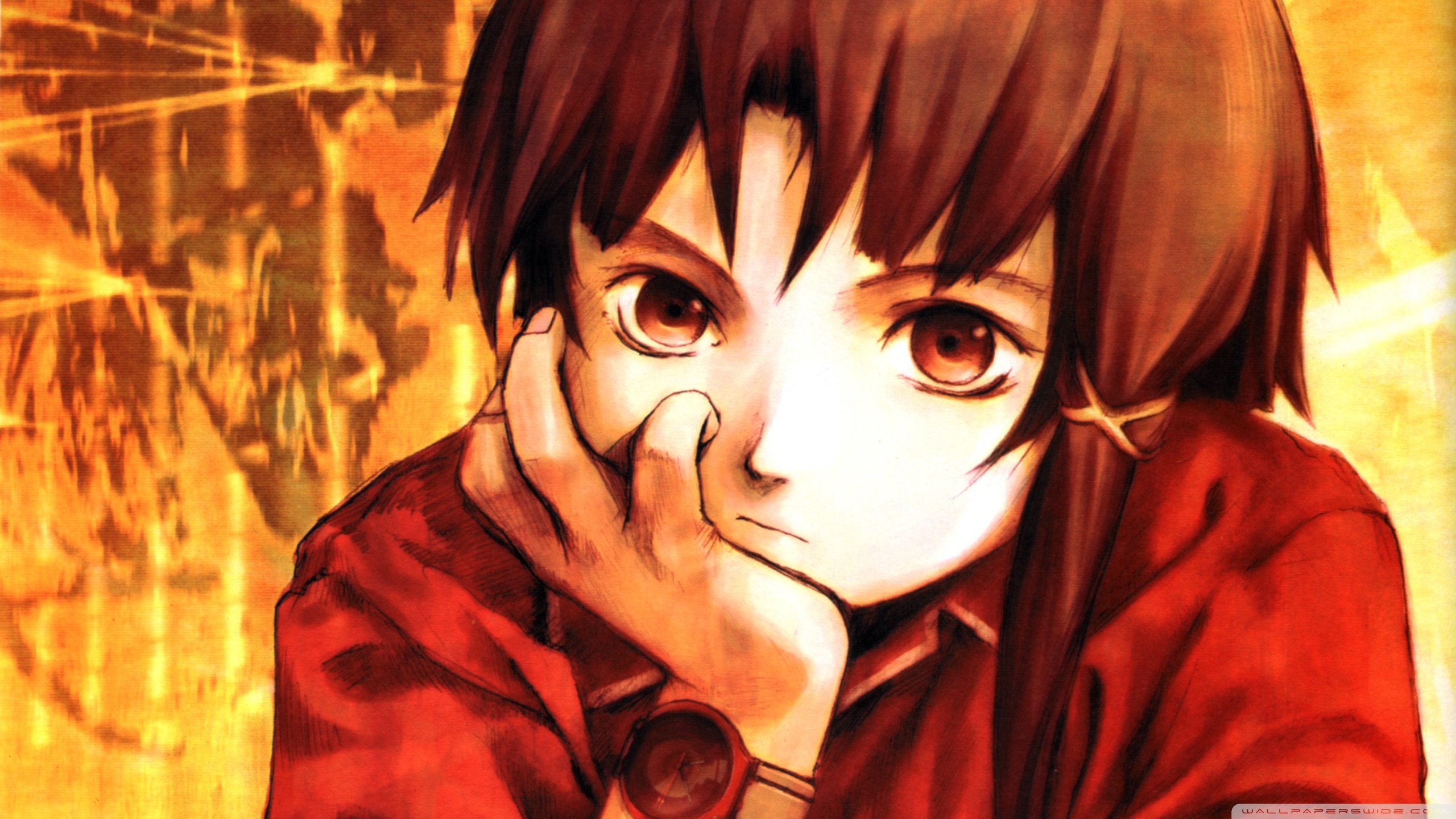
Lain’s body may remain in the physical world, but her consciousness stretches outward. Eventually, she learns that she is not entirely human. She’s a product of information, created as a link between the Wired and reality. This revelation shatters the last illusions of her identity. She becomes untethered from form.
Despite its high-concept premise, the series remains intimate. It never loses focus on Lain’s isolation and quiet suffering. Her loneliness is not born from circumstance—it is a condition of her very existence. She seeks connection, but every step she takes into the Wired pushes her further from tangible relationships.
By the final episodes, Lain must make a choice. Remain within the digital consciousness and become something eternal—or erase herself to restore balance to others’ lives. She chooses self-erasure, sacrificing her presence to give people back their sense of reality. This act isn’t framed as noble or tragic—it’s quiet, almost matter-of-fact.
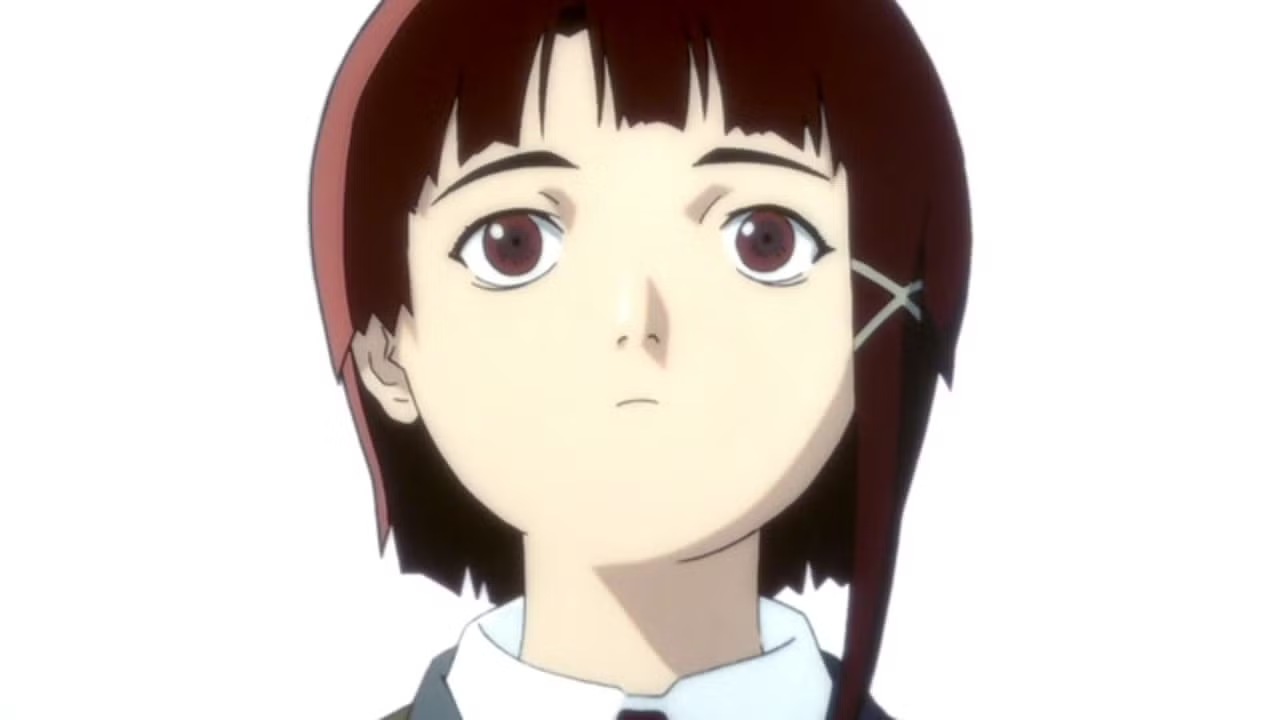
What’s left is an echo. Lain persists, quietly observing from the edges of existence. She watches her friends live unaware of her. She appears briefly in their lives, saying little. There’s something melancholy in this outcome. It’s not a victory. It’s a reminder that becoming something greater doesn’t always mean becoming something happier.
Serial Experiments Lain doesn’t offer comfort. Its ambiguity, layered metaphors, and fractured storytelling leave space for reflection rather than closure. It’s about losing yourself to a network, both technologically and psychologically. It’s about looking into screens too long and realizing you’ve forgotten your own reflection.
The sound design reinforces this mood. Whispered voices, distorted tones, and long silences create an oppressive auditory experience. The opening theme—“Duvet” by Bôa—sets the emotional tone immediately. Lyrics about confusion and distance echo the themes of identity and dissolution that follow.
What makes the series endure is its prescience. Released in 1998, it anticipated how the internet would reshape identity. It predicted how anonymity would create new selves and how data could become more real than physical presence. Its cold portrayal of the digital world now feels disturbingly familiar.
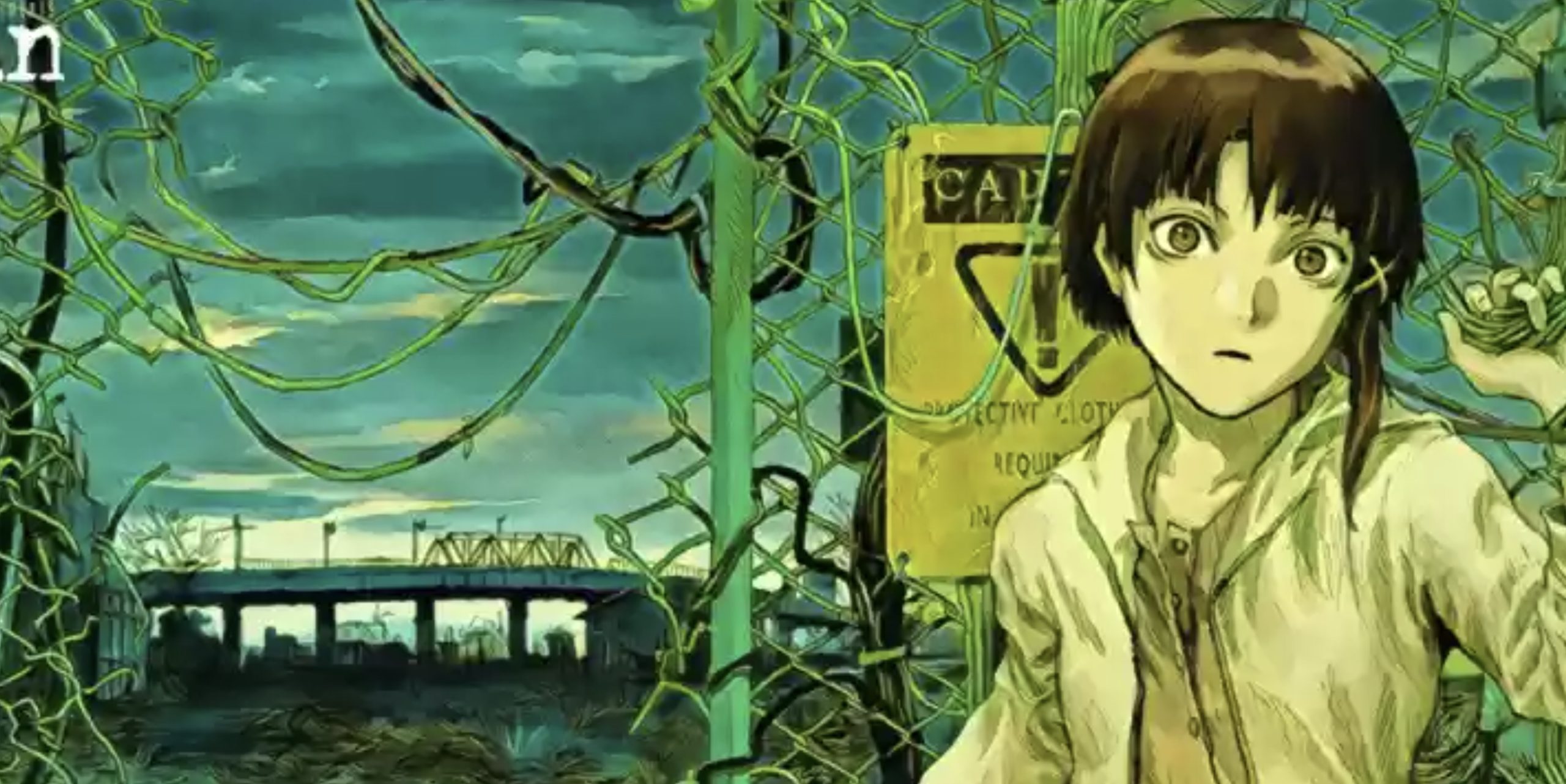
While many cyberpunk stories focus on dystopias filled with neon and rebellion, Lain is quiet and internal. The battle is not against systems or corporations but against the self. Lain isn’t trying to destroy the Wired—she’s trying to understand her place within it. That psychological conflict becomes more haunting than any sci-fi war.
There is no clear message. Serial Experiments Lain asks questions but withholds answers. It stares into the abyss of modern consciousness and simply reflects it. Its visuals, pace, and disjointed plot require patience. But for those willing to sit with its silence, it opens doors that few anime dare to touch.
Lain’s final smile—seen only by the audience—doesn’t explain anything. But it suggests peace. Not happiness, not certainty—just a quiet acceptance. And in a series filled with noise and distortion, that small, silent gesture may be the most powerful moment of all.
2. Hyouka
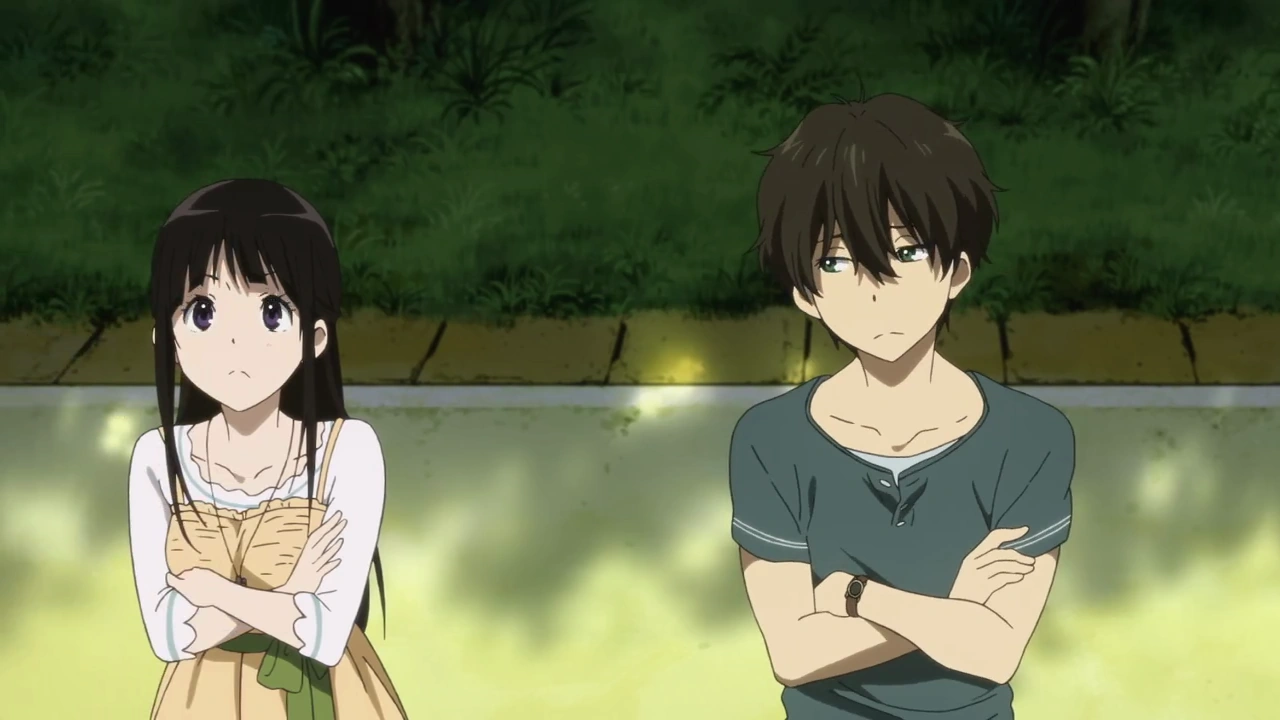
In the corridors of Kamiyama Senior High School, the figure of Houtarou Oreki looms large—a high school student who adheres steadfastly to his principle of energy conservation, eschewing unnecessary tasks and embracing efficiency above all else.
However, his tranquil existence is upended when his sister coerces him into joining the school’s Classics Club, thrusting him into intrigue and camaraderie.

Within the confines of the Classics Club, Houtarou encounters a diverse cast of characters, including the inquisitive and vivacious Eru Chitanda. With her insatiable curiosity and boundless enthusiasm, Eru serves as an amazing foil to Houtarou’s reserved demeanor, igniting a spark of excitement in his otherwise mundane existence.
Together with their fellow club members, they begin on a series of adventures, delving into mysteries both mundane and profound.
At the heart of Hyouka lies the enduring theme of friendship and understanding, as the young protagonists explore the complexities of adolescence and the mysteries that lie beneath the surface of everyday life. Through their interactions and shared experiences, they forge deep bonds and uncover the hidden truths that shape their world.
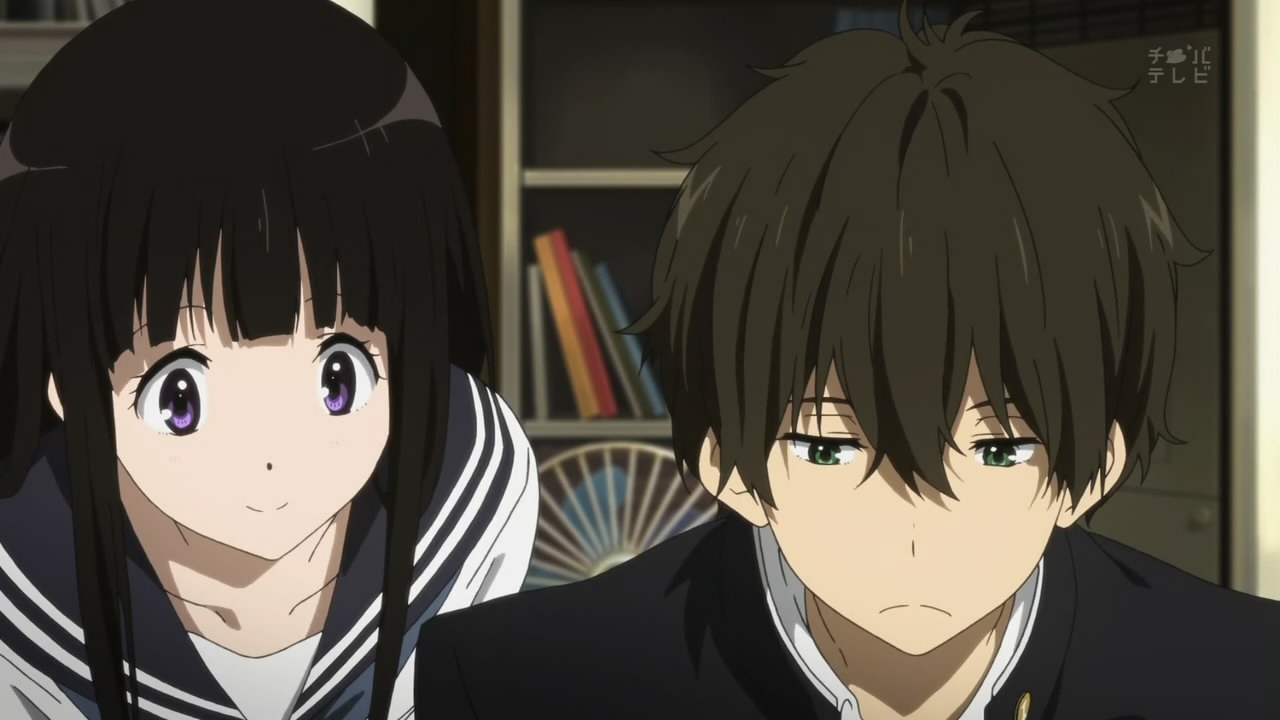
As Houtarou and Eru unravel the that cross their path, viewers are treated to an amazing exploration of human nature and the power of interpersonal dynamics.
From unraveling the origins of their club’s anthology, “Hyouka,” to solving seemingly trivial problems that pique Eru’s curiosity, each mystery serves as a stepping stone on their journey of self-discovery and mutual understanding.
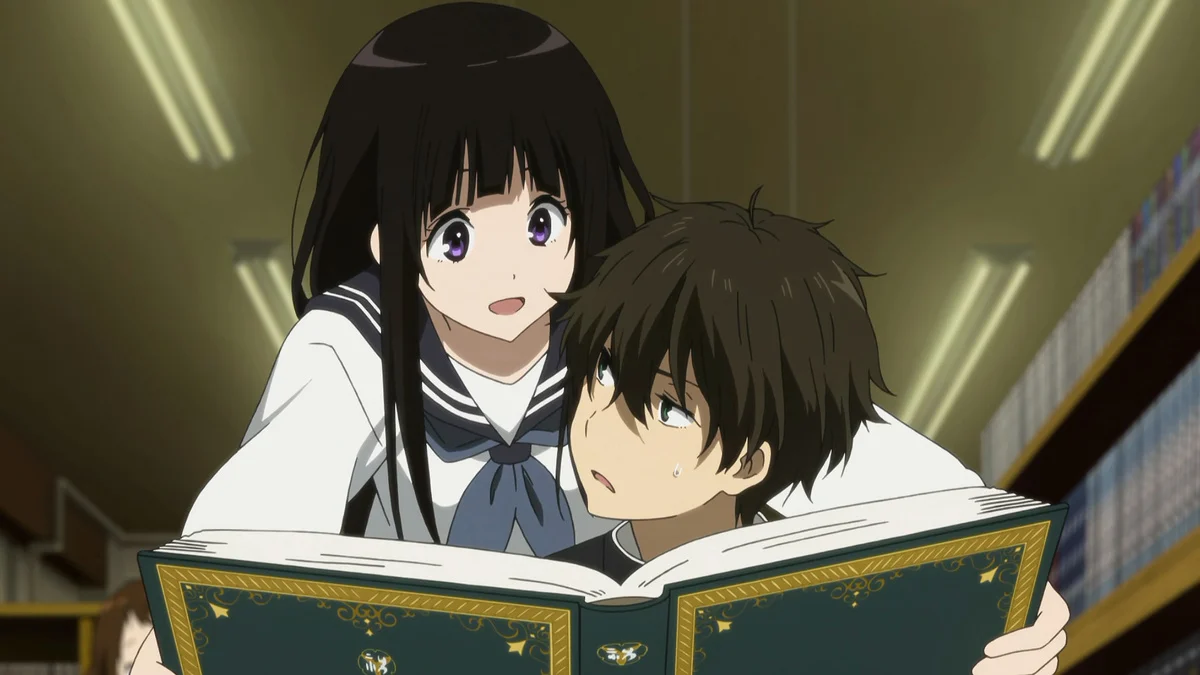
Hyouka, produced by Kyoto Animation, follows the life of high school student Houtarou Oreki, a boy who avoids effort unless absolutely necessary. His world begins to shift when he joins the Classic Literature Club at the request of his sister. There, he meets Eru Chitanda, whose boundless curiosity begins to chip away at his passive outlook.
Chitanda’s constant wonder becomes the catalyst for Oreki’s gradual transformation. Their dynamic is subtle yet powerful, with her spirited energy pulling Oreki into everyday mysteries. Each one may seem mundane, but they reflect something much deeper—questions about history, memory, and human nature. Her catchphrase, “I’m curious!” becomes the show’s emotional motor.
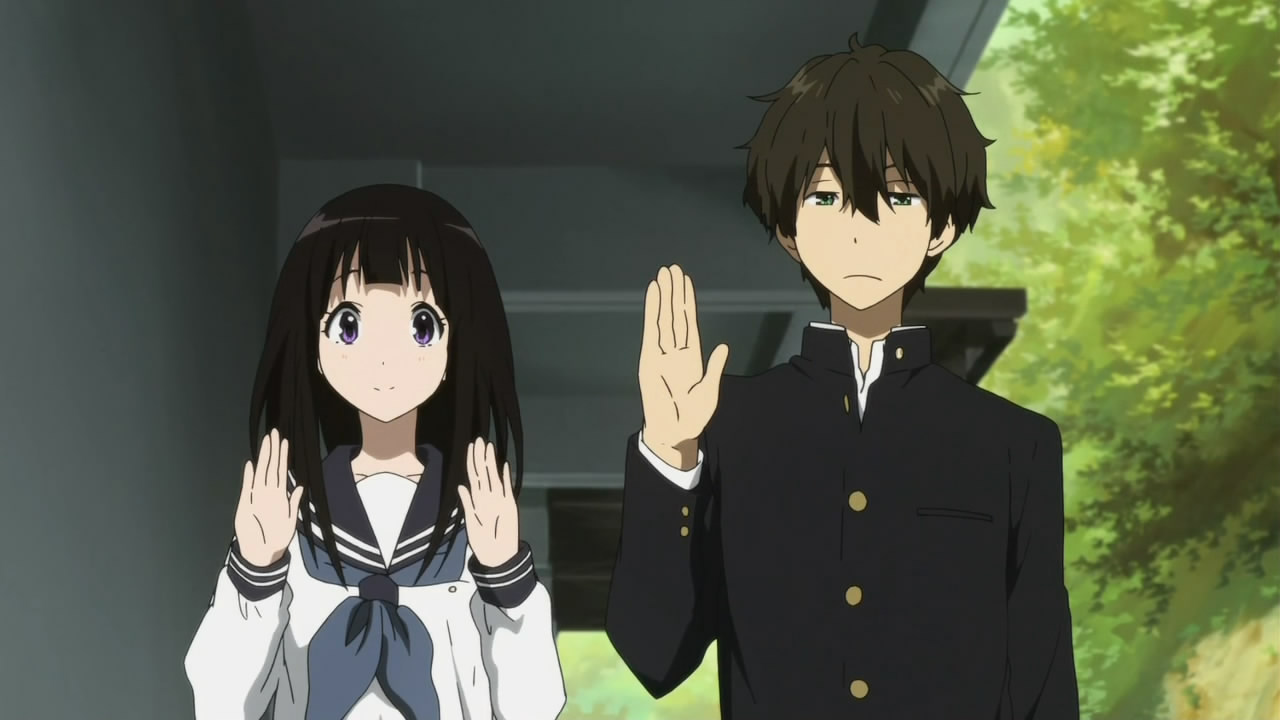
The other two main members of the club, Satoshi Fukube and Mayaka Ibara, round out the group with strong supporting perspectives. Satoshi, a self-proclaimed “database,” has a sharp memory but holds himself back from pursuing real depth. Mayaka is detail-oriented and emotionally intense, offering more grounded contrast to the dreamy energy Chitanda exudes.
The mysteries aren’t dramatic crimes but rather everyday questions. One such mystery involves a missing anthology called “Hyouka,” which reveals unexpected insights into the school’s past and Oreki’s sister’s motivations. These questions help the group navigate personal growth as much as they solve puzzles.
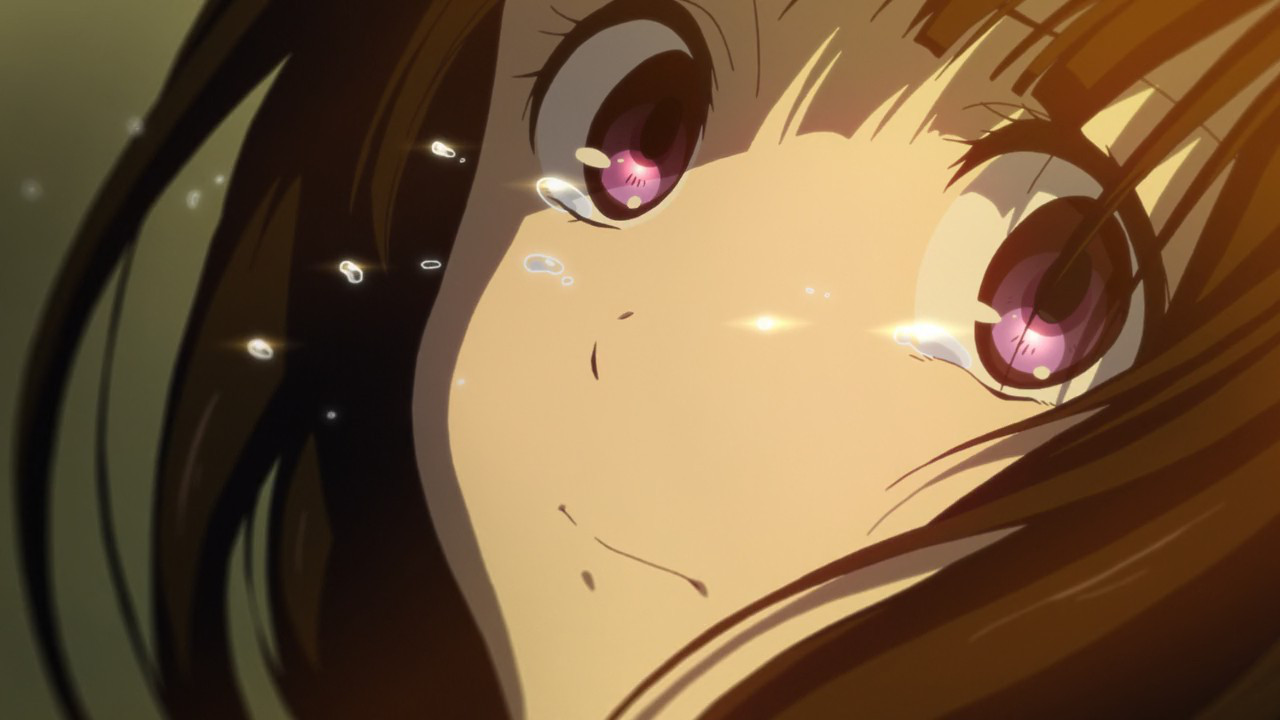
Oreki’s growth lies not in dramatic change but in subtle movement. He begins the series conserving energy in all he does, but by the end, his actions show increasing care and personal investment. His small gestures—staying late to help Chitanda, noticing details no one else sees—become signs of change.
The show’s style is quiet and reflective. Kyoto Animation brings a restrained elegance to each scene. Whether it’s the sunlight through a window or the ripple of emotions across a face, every frame feels deliberate. The series leans into atmosphere, making simple settings like classrooms and libraries feel full of quiet emotion.
The pacing is unhurried. It resists the fast beats typical of mystery anime. Each case takes time, reflecting how answers in life often arrive slowly. While some may find the story too slow, others will appreciate the calm rhythm and focus on thought over spectacle.
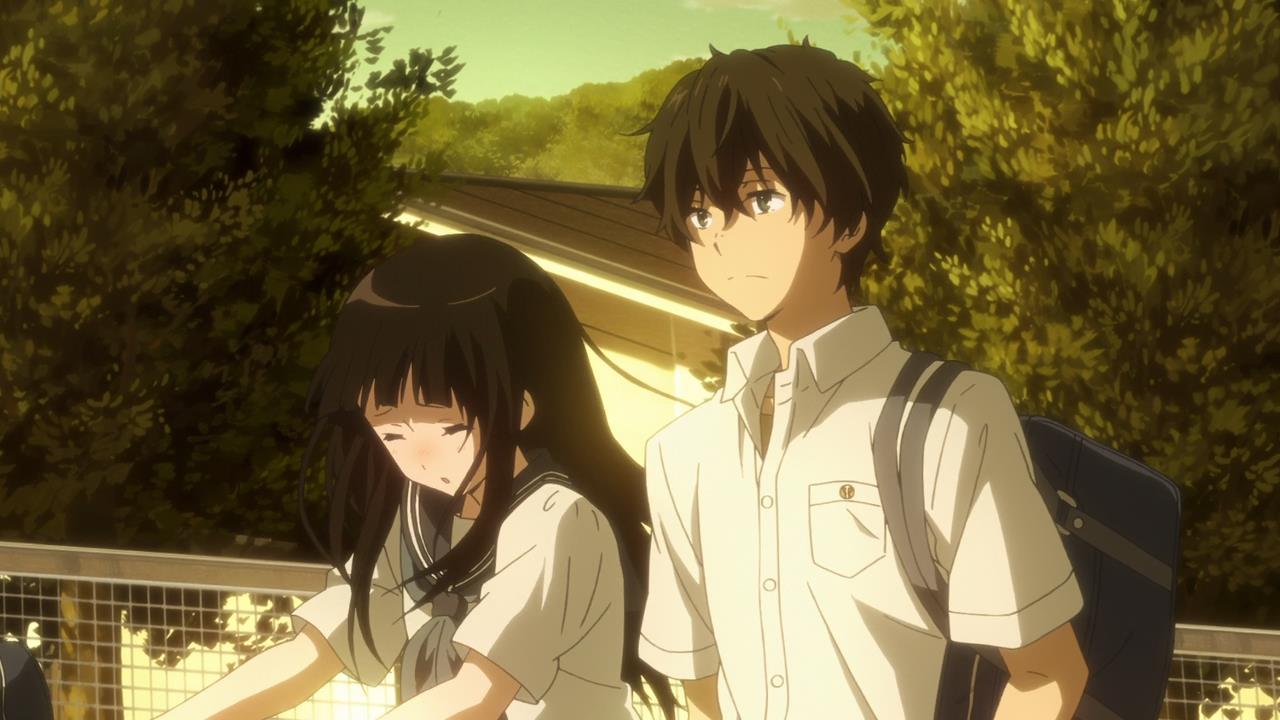
Chitanda’s role goes beyond just being the cheerful foil to Oreki. Her emotional honesty and passion for truth contrast with Oreki’s internal skepticism. She doesn’t just drive the plot—she awakens something dormant in him. Their connection grows with layers of tension, unsaid words, and shared glances.
Satoshi’s internal conflict adds another layer. Despite his easygoing persona, he harbors envy toward Oreki’s deductive abilities. His self-awareness and refusal to compete hint at his fear of being second-best. His struggle reflects the real pressures of teenage insecurity and self-worth.
Mayaka deals with her own challenges, from her unreciprocated feelings for Satoshi to her pursuit of creative validation. Her arc, especially in the manga club storyline, reveals a quiet intensity. She’s often dismissed, but the series gives her moments of real strength and emotional clarity.
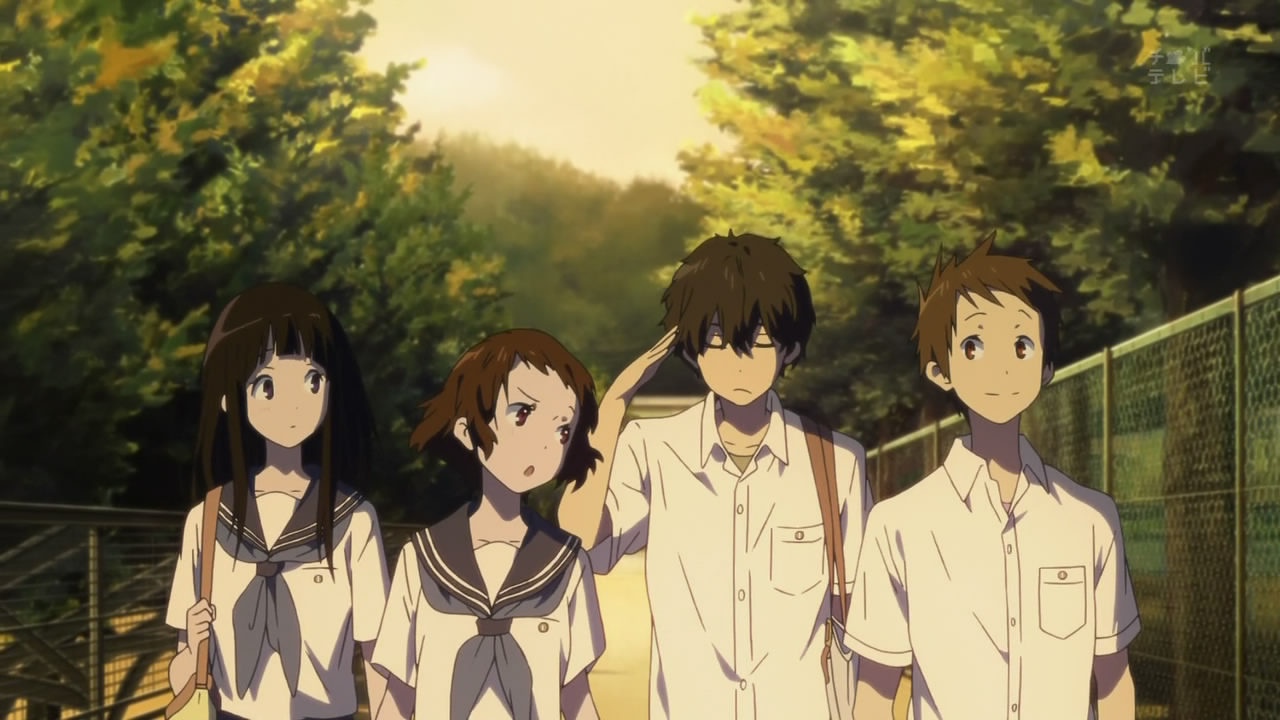
The show’s biggest strength is how it manages to use small moments to reflect large truths. Conversations about forgotten books or festival logistics open paths to discussing isolation, pressure, and personal identity. These emotional undercurrents give weight to seemingly trivial mysteries.
Despite the emotional growth, the series avoids dramatic resolution. Oreki and Chitanda’s relationship remains suspended—filled with potential, never pushed forward. This ambiguity may frustrate viewers seeking romantic closure, but it fits the series’ gentle realism. It doesn’t force progress where it hasn’t fully formed.
One standout episode is the cultural festival arc, where Oreki is manipulated into doing more than he realizes. This moment breaks his routine and shows how easily people can be influenced while believing they’re acting of their own will. It’s a rare moment of external conflict in a mostly internal show.

The soundtrack supports the atmosphere without overwhelming it. Light piano pieces and gentle strings underscore the emotional shifts without drawing too much attention. The opening and ending themes fit the tone, with “Yasashisa no Riyuu” offering a catchy yet meaningful introduction to each episode’s themes.
What makes Hyouka different from most slice-of-life anime is how thoughtfully it treats teenage doubt. It doesn’t paint youth as all fun or pain, but something in between—filled with quiet questions, hesitant steps, and a sense of time slowly passing. Every mystery solved leaves a residue of feeling.
Its rewatch value is surprisingly high. The first viewing might focus on solving the case at hand, but repeat viewings reveal expressions, background details, and lines loaded with double meaning. Kyoto Animation’s attention to detail rewards close observation and emotional memory.
Some viewers may find the lack of a clear conclusion disappointing. The series doesn’t end with major changes or confessions. Instead, it leaves characters where they are—growing, feeling, and not quite ready to break free. This choice makes the experience linger even longer in the mind.
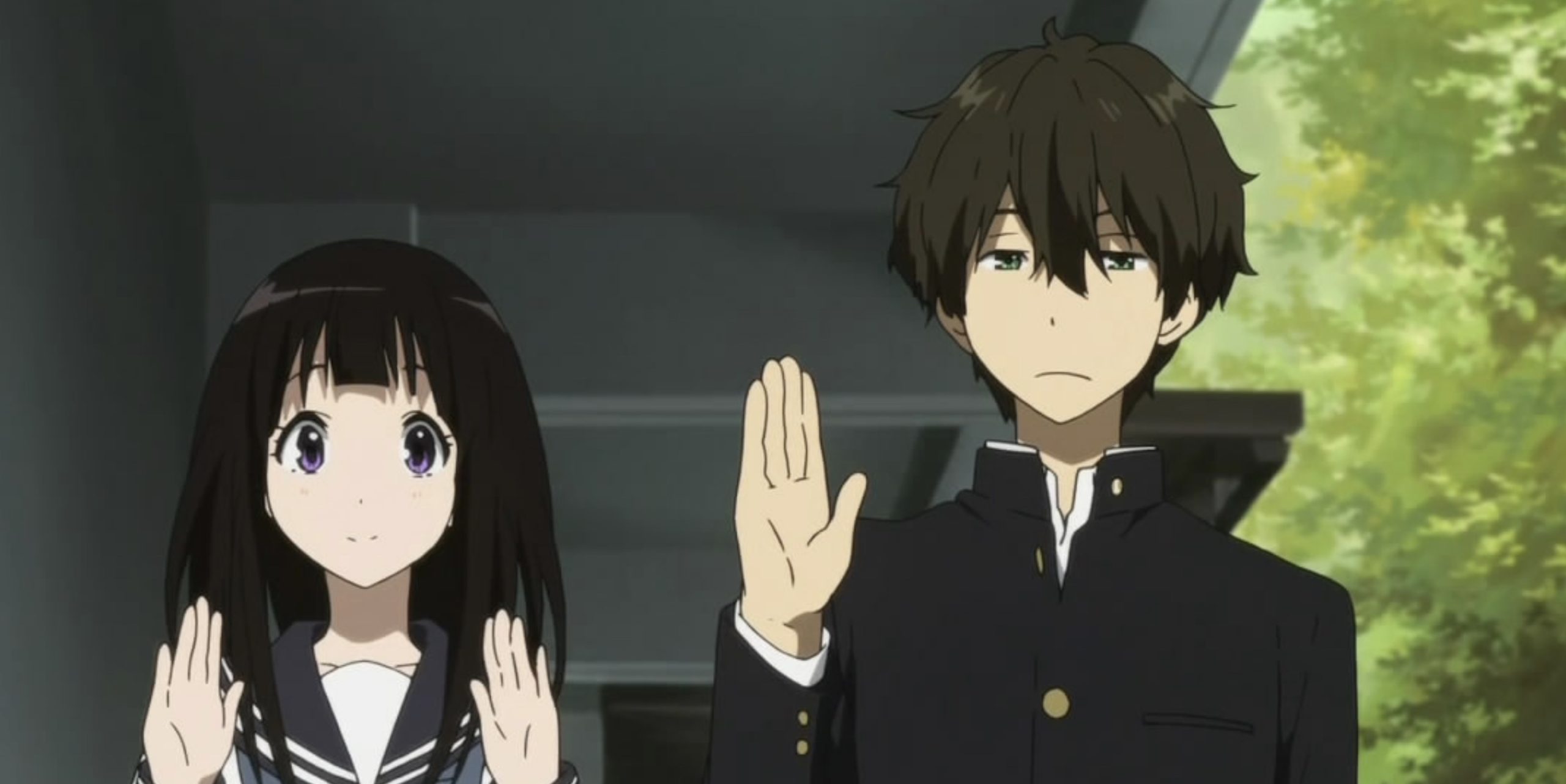
The art design balances realism with touches of whimsy. Chitanda’s eyes, in particular, are often animated with dazzling detail. This visual motif becomes symbolic of her curiosity—something Oreki can’t turn away from. Lighting and composition shift with emotion, not just setting.
Hyouka may not appeal to those who want quick resolutions or high-stakes plots. But for those who enjoy introspective stories and subtle relationship development, it offers rich emotional and philosophical content. It turns quiet days into windows for understanding others and oneself.
Though it ends without loud declarations, the final moments say much. Oreki’s internal monologue, paired with a soft sunset and unspoken feeling, suggests something just beginning. The series has no need to wrap everything neatly—because life doesn’t, either.
1. My Little Monster
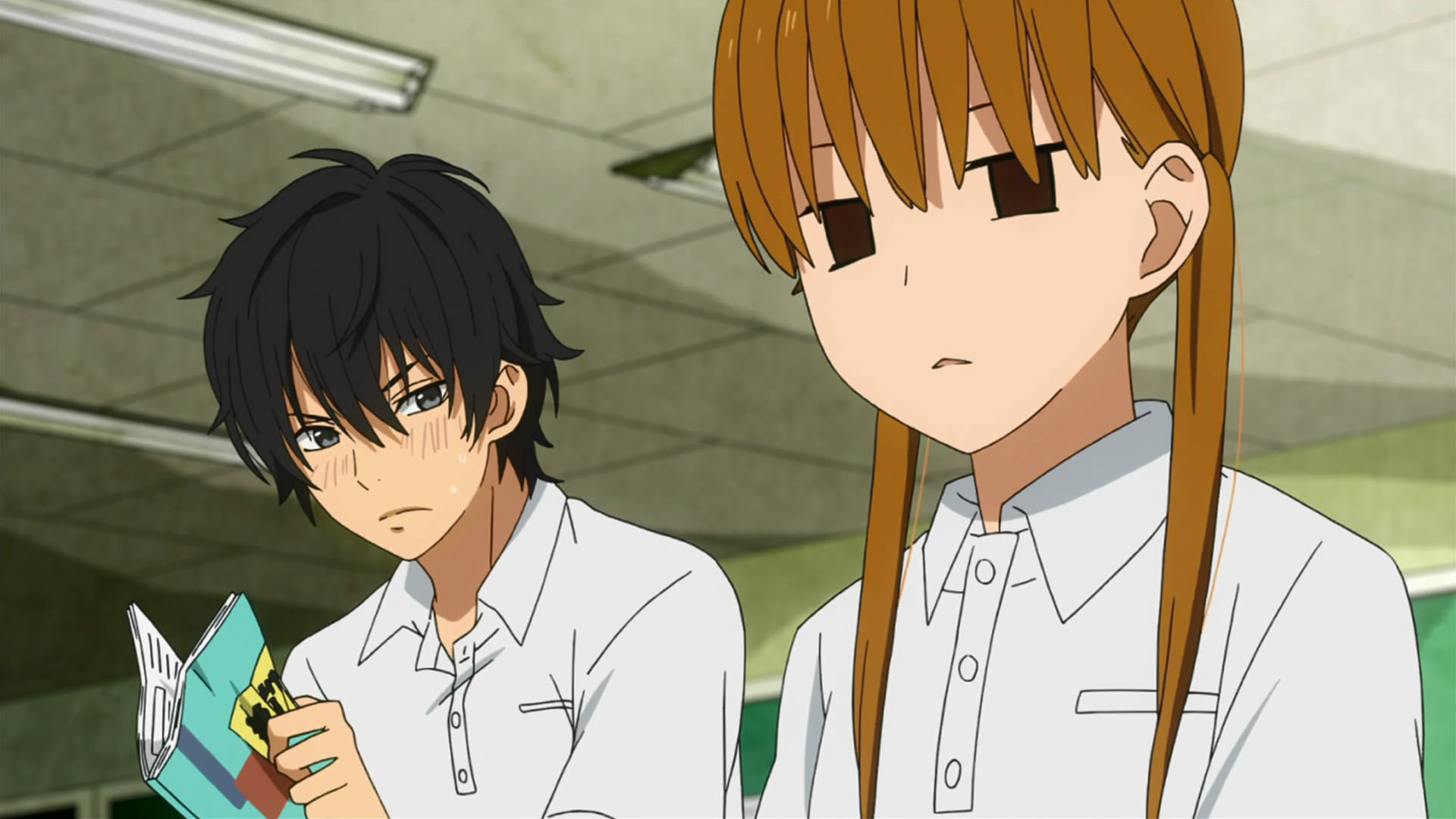
In high school, My Little Monster reveals the amazing tale of Mizutani Shizuku and Haru Yoshida—a duo whose unlikely relationship defies the odds.
Mizutani, cold and solitary following the trials of her middle school years, finds herself drawn into the whirlwind Haru, an impulsive and boisterous soul prone to constant altercations.
Their fateful encounter occurs when Mizutani, tasked with delivering class notes to the absent Haru, finds herself thrust into his tumultuous orbit. In a moment of unbridled candor, Haru confesses his love for Mizutani, sparking the flames of an improbable friendship between two souls worlds apart.
As Mizutani and Haru explore the tumultuous waters of adolescence, they grapple with the challenges of relating to others and, at times, even to each other. Despite their stark differences in personality, their bond deepens as they confront the complexities of friendship, love, and self-discovery.
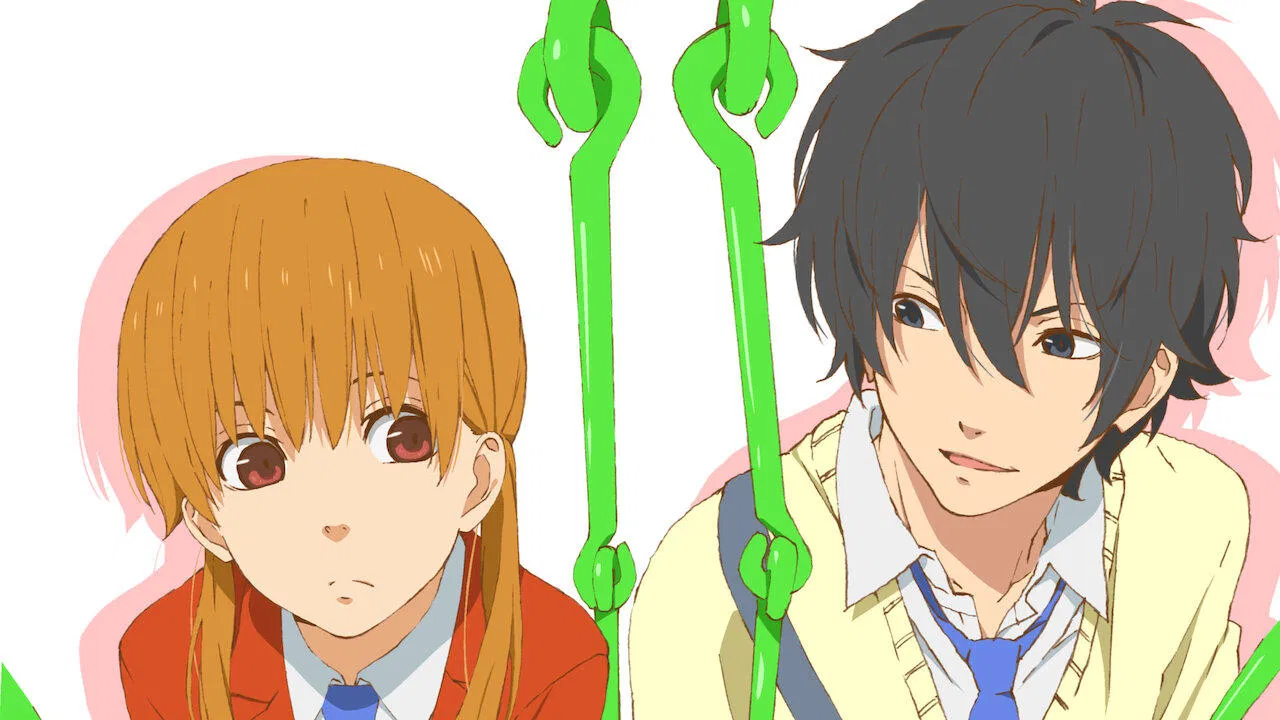
My Little Monster offers viewers a poignant journey through the nuances of human connection, exploring themes of isolation, friendship, and the transformative power of love.
Through the lens of Mizutani and Haru’s evolving relationship, the series showcases the profound impact of understanding and empathy in bridging the divide between hearts.
As the story reveals, viewers are treated to moments of laughter, tears, and heartfelt revelations, as Mizutani and Haru begin on a journey of mutual growth and acceptance.
Along the way, they confront their inner demons and emerge stronger, their characters enriched by the bonds they forge and the challenges they overcome.

Shizuku Mizutani only cares about grades. Haru Yoshida is known for violence and rarely shows up at school. Their personalities couldn’t be more different, yet their relationship kicks off with a twist—Haru mistakes Shizuku’s kindness for affection. This misunderstanding fuels the start of their bizarre but compelling connection.
The anime examines their dynamic through awkward encounters, honest moments, and emotional confusion. Shizuku, once focused solely on academic success, begins to reassess her values. Haru, on the other hand, learns how to communicate and connect without scaring people off. These shifts make their story meaningful.
The series doesn’t romanticize its characters’ flaws. Haru struggles with violence and impulsive behavior. Shizuku often avoids her feelings or hides behind logic. Their development feels natural, layered through actions and quiet changes instead of dramatic shifts. These elements help the viewer invest in their relationship.
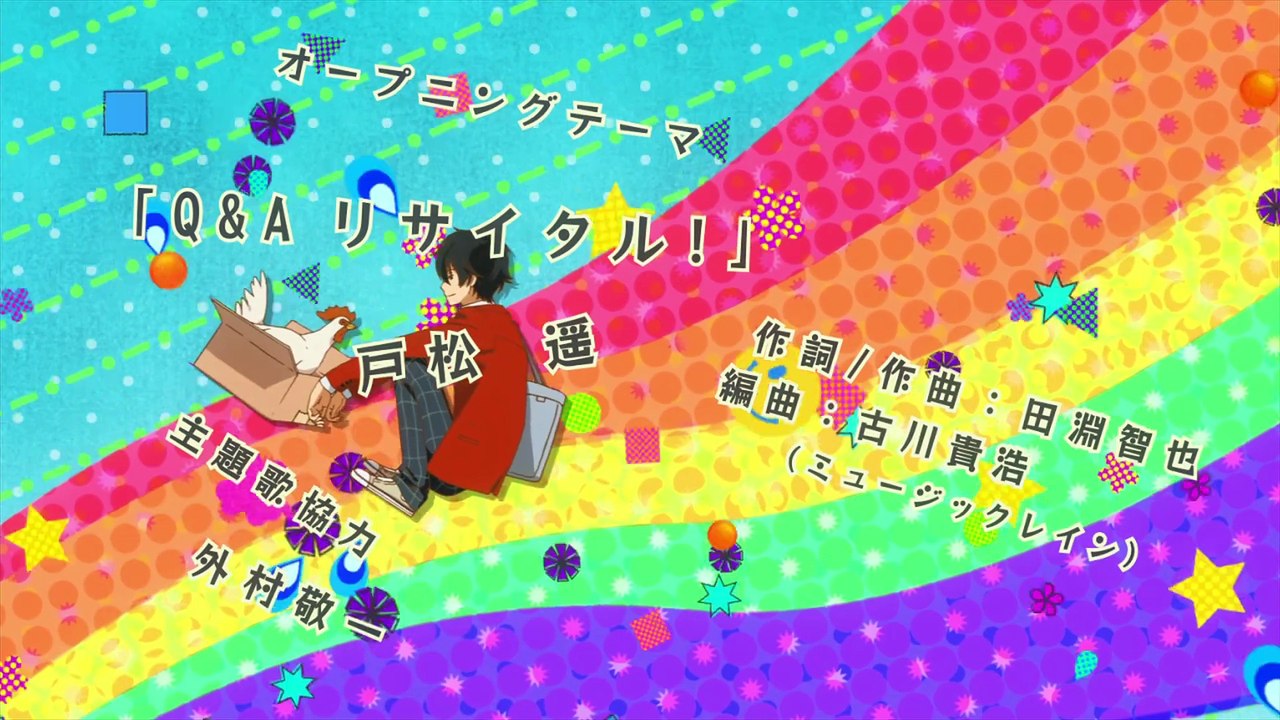
Other characters—like Sasayan, Natsume, and Yamaken—add to the story’s depth. Each of them has a role to play in showing what it means to care for others, even if love isn’t involved. Their moments often highlight what Shizuku and Haru are missing: empathy, perspective, and self-awareness.
The art style uses soft colors and minimal backgrounds, helping to focus attention on facial expressions. These subtleties become essential, especially in a show driven by emotional shifts. A glance, a pause, or a look of hesitation speaks volumes when words fall short between characters.
The animation maintains this emotional rhythm without distracting from the plot. While action scenes are rare, timing and visual cues carry the emotional tone. Haru’s unpredictable personality is often matched with physical gags, while Shizuku’s internal conflict appears in her quiet, repetitive study habits.
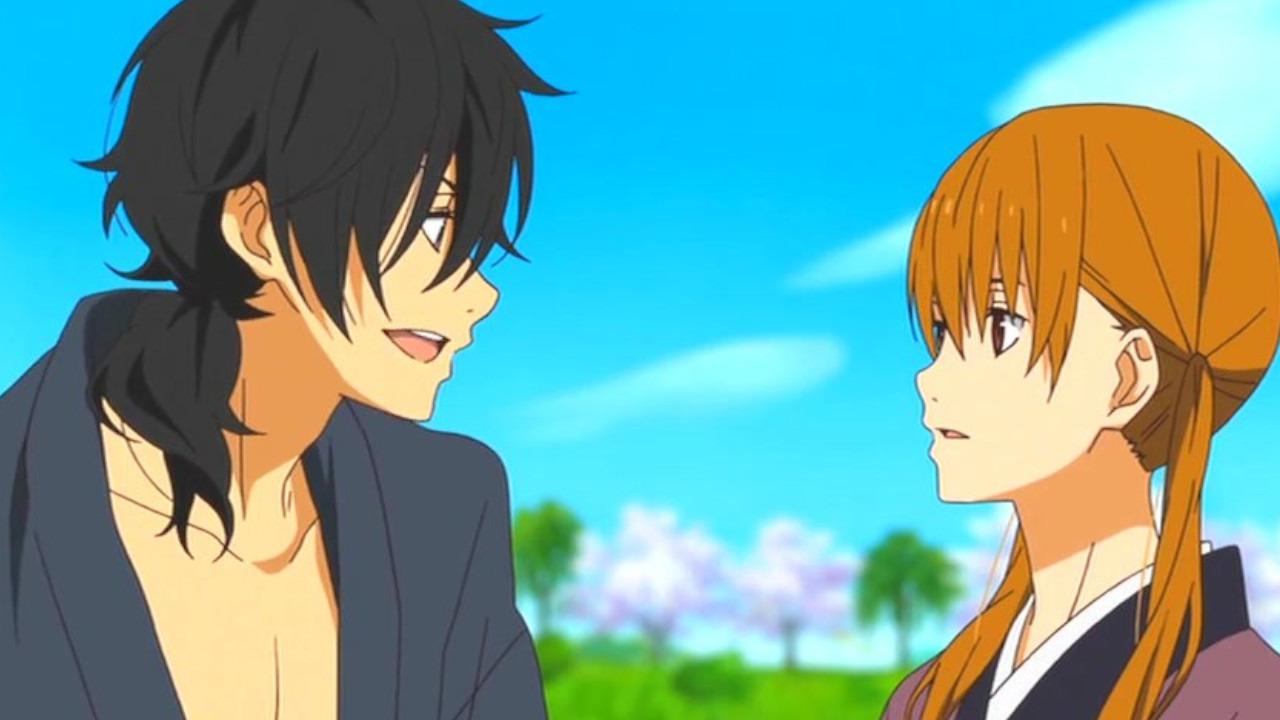
Dialogue shines when Shizuku and Haru try to be honest. Their attempts often backfire or end in confusion, but that’s part of what feels real. Emotional honesty, especially in teenage years, rarely comes out clean or clear. This messiness adds weight to their moments together.
The show doesn’t resolve everything. While their feelings are openly admitted by the end, many issues remain. Haru’s violent tendencies and Shizuku’s emotional walls don’t disappear. Some story threads stay open, suggesting the anime reflects the ongoing process of growth rather than a clean finish.
Though romance drives the narrative, personal development holds equal weight. It’s not about getting together—it’s about learning how to be ready for someone else. That process isn’t easy. It takes discomfort, mistakes, and vulnerability, all of which the anime reflects without sugarcoating.
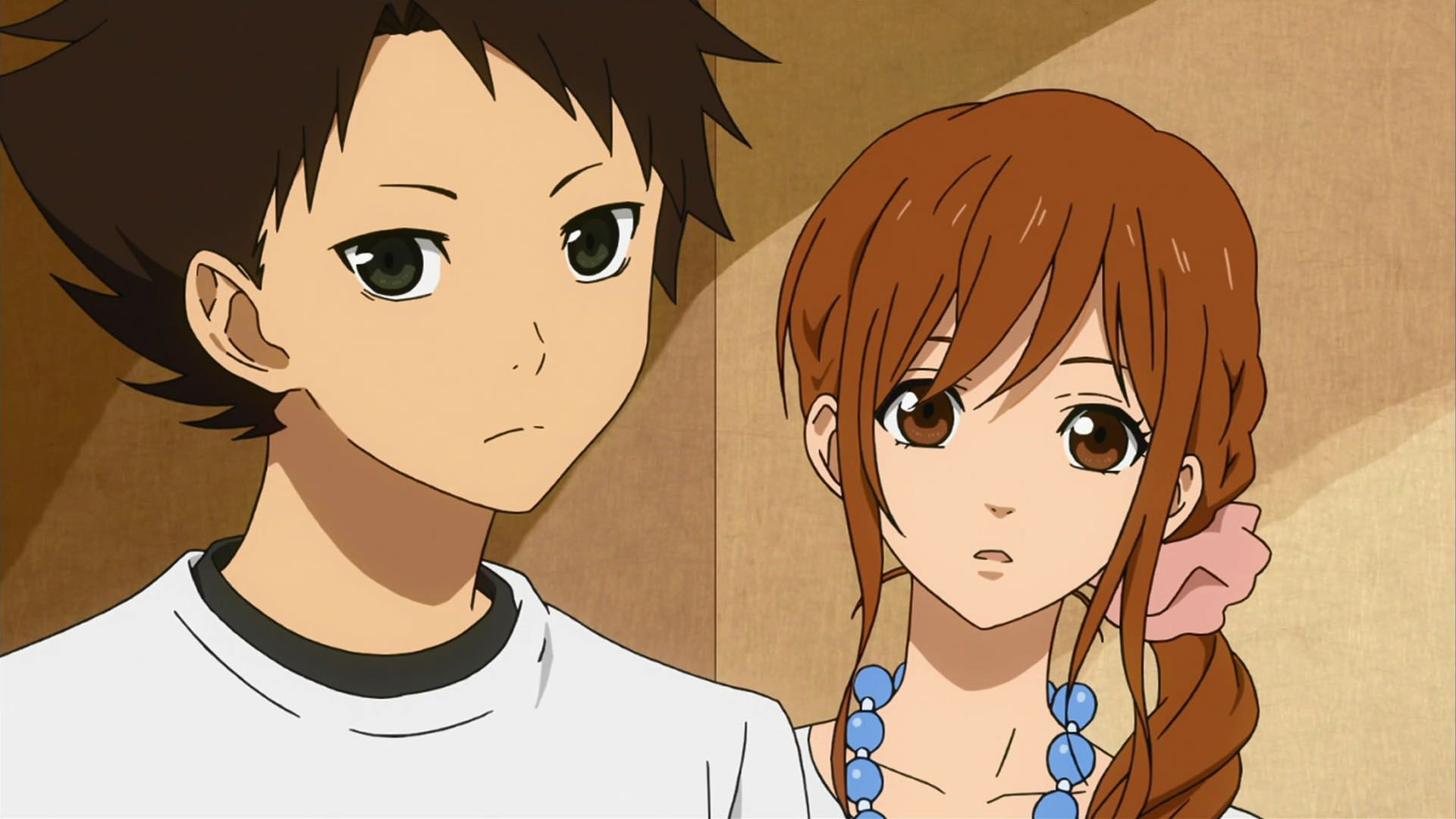
Natsume’s subplot, for example, mirrors Shizuku’s arc in small ways. She yearns for connection but avoids people. Her growth feels genuine as she tries to balance friendships, attention, and her self-worth. Her story reinforces the show’s central message: emotional growth takes time and courage.
The humor keeps things from feeling too heavy. Haru’s odd behavior and blunt honesty often contrast with Shizuku’s deadpan reactions. Their chemistry leans on opposites attracting, but the comedy often reveals emotional truth in disguise, especially when misunderstandings bring out deeper feelings.
Sasayan provides a grounded presence. He offers advice without pushing, watches without judging, and brings calm to a story full of emotional storms. His role may seem small, but his perspective makes the other characters’ chaos more digestible and real.

The anime’s pacing can feel uneven. Some episodes flow effortlessly, while others linger too long on the same emotional point. This occasional stagnation might frustrate viewers who want quicker development, but it also mirrors the hesitant nature of Shizuku and Haru’s relationship.
The opening theme “Q&A Recital!” matches the show’s quirky energy. Its fast rhythm and vibrant visuals introduce the tone perfectly. Meanwhile, the ending theme shifts to a more introspective mood, reflecting the emotional weight that often lingers after each episode.
Even though the anime doesn’t adapt the full manga, it builds a believable and immersive world. The focus stays tight on its characters’ emotions, never losing sight of the core relationship while weaving in strong side plots. That balance gives it a unique charm.
The school setting plays an essential role. It’s not just a backdrop—it shapes their daily lives, routines, and chances to grow. Hallways, rooftops, and classrooms become places of silent tension, awkward meetings, or quiet acceptance. These mundane spaces feel emotionally charged.
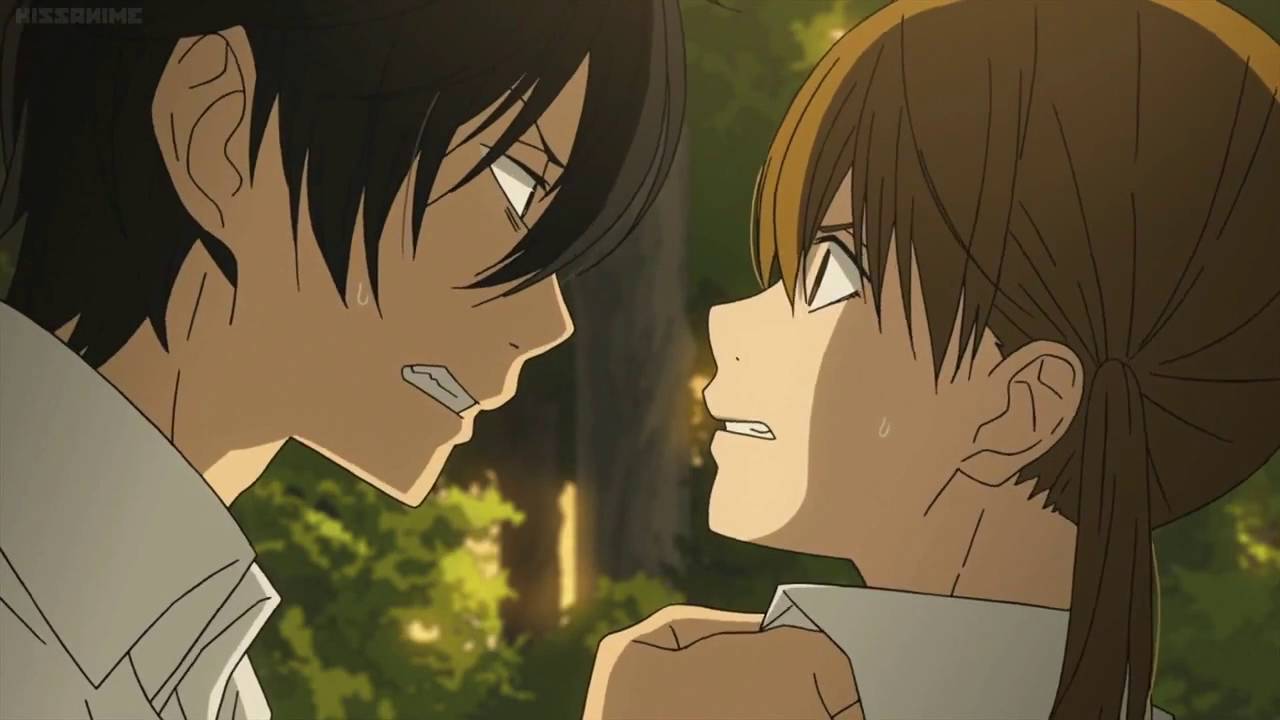
Haru’s relationship with his older brother adds a layer of mystery to his behavior. It hints at a complex past without overexplaining. That restraint allows the viewer to infer emotional scars rather than being fed information. It’s subtle but effective storytelling.
Similarly, Shizuku’s relationship with her family adds to her personality. Her parents, especially her ambitious mother, shape how she views success and emotion. The show never leans too hard on this, but it adds valuable texture to her internal conflict and character choices.
Viewers often expect a romantic anime to end with a confession, kiss, or official pairing. My Little Monster avoids that path. Instead, it emphasizes progress over perfection. Emotional readiness takes time, and that message lingers even as the final credits roll.
Despite the lack of full closure, the emotional highs remain strong. Watching Haru and Shizuku try, fail, and try again never gets old. Their sincerity makes their relationship believable. Even their distance feels honest, like two people learning to speak the same language.

This anime might not satisfy everyone, especially those wanting neat resolutions. But it rewards viewers who appreciate nuance. The focus isn’t just on falling in love—it’s on becoming someone who can love. That idea makes My Little Monster more than just another romantic comedy.
Its charm lies in its messiness. Characters don’t always say the right thing or make the best choices. But they care, even when they struggle to show it. That emotional honesty, paired with simple storytelling, gives the show its heart.
For those who enjoy romance that leans on character-driven stories, this anime offers a satisfying experience. It doesn’t wrap everything up in a bow, but it leaves behind something better—growth, self-awareness, and the quiet hope that love will find its way, eventually.


